How to write a case study — examples, templates, and tools

It’s a marketer’s job to communicate the effectiveness of a product or service to potential and current customers to convince them to buy and keep business moving. One of the best methods for doing this is to share success stories that are relatable to prospects and customers based on their pain points, experiences, and overall needs.
That’s where case studies come in. Case studies are an essential part of a content marketing plan. These in-depth stories of customer experiences are some of the most effective at demonstrating the value of a product or service. Yet many marketers don’t use them, whether because of their regimented formats or the process of customer involvement and approval.
A case study is a powerful tool for showcasing your hard work and the success your customer achieved. But writing a great case study can be difficult if you’ve never done it before or if it’s been a while. This guide will show you how to write an effective case study and provide real-world examples and templates that will keep readers engaged and support your business.
In this article, you’ll learn:

What is a case study?
How to write a case study, case study templates, case study examples, case study tools.
A case study is the detailed story of a customer’s experience with a product or service that demonstrates their success and often includes measurable outcomes. Case studies are used in a range of fields and for various reasons, from business to academic research. They’re especially impactful in marketing as brands work to convince and convert consumers with relatable, real-world stories of actual customer experiences.
The best case studies tell the story of a customer’s success, including the steps they took, the results they achieved, and the support they received from a brand along the way. To write a great case study, you need to:
- Celebrate the customer and make them — not a product or service — the star of the story.
- Craft the story with specific audiences or target segments in mind so that the story of one customer will be viewed as relatable and actionable for another customer.
- Write copy that is easy to read and engaging so that readers will gain the insights and messages intended.
- Follow a standardized format that includes all of the essentials a potential customer would find interesting and useful.
- Support all of the claims for success made in the story with data in the forms of hard numbers and customer statements.
Case studies are a type of review but more in depth, aiming to show — rather than just tell — the positive experiences that customers have with a brand. Notably, 89% of consumers read reviews before deciding to buy, and 79% view case study content as part of their purchasing process. When it comes to B2B sales, 52% of buyers rank case studies as an important part of their evaluation process.
Telling a brand story through the experience of a tried-and-true customer matters. The story is relatable to potential new customers as they imagine themselves in the shoes of the company or individual featured in the case study. Showcasing previous customers can help new ones see themselves engaging with your brand in the ways that are most meaningful to them.
Besides sharing the perspective of another customer, case studies stand out from other content marketing forms because they are based on evidence. Whether pulling from client testimonials or data-driven results, case studies tend to have more impact on new business because the story contains information that is both objective (data) and subjective (customer experience) — and the brand doesn’t sound too self-promotional.

Case studies are unique in that there’s a fairly standardized format for telling a customer’s story. But that doesn’t mean there isn’t room for creativity. It’s all about making sure that teams are clear on the goals for the case study — along with strategies for supporting content and channels — and understanding how the story fits within the framework of the company’s overall marketing goals.
Here are the basic steps to writing a good case study.
1. Identify your goal
Start by defining exactly who your case study will be designed to help. Case studies are about specific instances where a company works with a customer to achieve a goal. Identify which customers are likely to have these goals, as well as other needs the story should cover to appeal to them.
The answer is often found in one of the buyer personas that have been constructed as part of your larger marketing strategy. This can include anything from new leads generated by the marketing team to long-term customers that are being pressed for cross-sell opportunities. In all of these cases, demonstrating value through a relatable customer success story can be part of the solution to conversion.
2. Choose your client or subject
Who you highlight matters. Case studies tie brands together that might otherwise not cross paths. A writer will want to ensure that the highlighted customer aligns with their own company’s brand identity and offerings. Look for a customer with positive name recognition who has had great success with a product or service and is willing to be an advocate.
The client should also match up with the identified target audience. Whichever company or individual is selected should be a reflection of other potential customers who can see themselves in similar circumstances, having the same problems and possible solutions.
Some of the most compelling case studies feature customers who:
- Switch from one product or service to another while naming competitors that missed the mark.
- Experience measurable results that are relatable to others in a specific industry.
- Represent well-known brands and recognizable names that are likely to compel action.
- Advocate for a product or service as a champion and are well-versed in its advantages.
Whoever or whatever customer is selected, marketers must ensure they have the permission of the company involved before getting started. Some brands have strict review and approval procedures for any official marketing or promotional materials that include their name. Acquiring those approvals in advance will prevent any miscommunication or wasted effort if there is an issue with their legal or compliance teams.
3. Conduct research and compile data
Substantiating the claims made in a case study — either by the marketing team or customers themselves — adds validity to the story. To do this, include data and feedback from the client that defines what success looks like. This can be anything from demonstrating return on investment (ROI) to a specific metric the customer was striving to improve. Case studies should prove how an outcome was achieved and show tangible results that indicate to the customer that your solution is the right one.
This step could also include customer interviews. Make sure that the people being interviewed are key stakeholders in the purchase decision or deployment and use of the product or service that is being highlighted. Content writers should work off a set list of questions prepared in advance. It can be helpful to share these with the interviewees beforehand so they have time to consider and craft their responses. One of the best interview tactics to keep in mind is to ask questions where yes and no are not natural answers. This way, your subject will provide more open-ended responses that produce more meaningful content.
4. Choose the right format
There are a number of different ways to format a case study. Depending on what you hope to achieve, one style will be better than another. However, there are some common elements to include, such as:
- An engaging headline
- A subject and customer introduction
- The unique challenge or challenges the customer faced
- The solution the customer used to solve the problem
- The results achieved
- Data and statistics to back up claims of success
- A strong call to action (CTA) to engage with the vendor
It’s also important to note that while case studies are traditionally written as stories, they don’t have to be in a written format. Some companies choose to get more creative with their case studies and produce multimedia content, depending on their audience and objectives. Case study formats can include traditional print stories, interactive web or social content, data-heavy infographics, professionally shot videos, podcasts, and more.
5. Write your case study
We’ll go into more detail later about how exactly to write a case study, including templates and examples. Generally speaking, though, there are a few things to keep in mind when writing your case study.
- Be clear and concise. Readers want to get to the point of the story quickly and easily, and they’ll be looking to see themselves reflected in the story right from the start.
- Provide a big picture. Always make sure to explain who the client is, their goals, and how they achieved success in a short introduction to engage the reader.
- Construct a clear narrative. Stick to the story from the perspective of the customer and what they needed to solve instead of just listing product features or benefits.
- Leverage graphics. Incorporating infographics, charts, and sidebars can be a more engaging and eye-catching way to share key statistics and data in readable ways.
- Offer the right amount of detail. Most case studies are one or two pages with clear sections that a reader can skim to find the information most important to them.
- Include data to support claims. Show real results — both facts and figures and customer quotes — to demonstrate credibility and prove the solution works.
6. Promote your story
Marketers have a number of options for distribution of a freshly minted case study. Many brands choose to publish case studies on their website and post them on social media. This can help support SEO and organic content strategies while also boosting company credibility and trust as visitors see that other businesses have used the product or service.
Marketers are always looking for quality content they can use for lead generation. Consider offering a case study as gated content behind a form on a landing page or as an offer in an email message. One great way to do this is to summarize the content and tease the full story available for download after the user takes an action.
Sales teams can also leverage case studies, so be sure they are aware that the assets exist once they’re published. Especially when it comes to larger B2B sales, companies often ask for examples of similar customer challenges that have been solved.
Now that you’ve learned a bit about case studies and what they should include, you may be wondering how to start creating great customer story content. Here are a couple of templates you can use to structure your case study.
Template 1 — Challenge-solution-result format
- Start with an engaging title. This should be fewer than 70 characters long for SEO best practices. One of the best ways to approach the title is to include the customer’s name and a hint at the challenge they overcame in the end.
- Create an introduction. Lead with an explanation as to who the customer is, the need they had, and the opportunity they found with a specific product or solution. Writers can also suggest the success the customer experienced with the solution they chose.
- Present the challenge. This should be several paragraphs long and explain the problem the customer faced and the issues they were trying to solve. Details should tie into the company’s products and services naturally. This section needs to be the most relatable to the reader so they can picture themselves in a similar situation.
- Share the solution. Explain which product or service offered was the ideal fit for the customer and why. Feel free to delve into their experience setting up, purchasing, and onboarding the solution.
- Explain the results. Demonstrate the impact of the solution they chose by backing up their positive experience with data. Fill in with customer quotes and tangible, measurable results that show the effect of their choice.
- Ask for action. Include a CTA at the end of the case study that invites readers to reach out for more information, try a demo, or learn more — to nurture them further in the marketing pipeline. What you ask of the reader should tie directly into the goals that were established for the case study in the first place.
Template 2 — Data-driven format
- Start with an engaging title. Be sure to include a statistic or data point in the first 70 characters. Again, it’s best to include the customer’s name as part of the title.
- Create an overview. Share the customer’s background and a short version of the challenge they faced. Present the reason a particular product or service was chosen, and feel free to include quotes from the customer about their selection process.
- Present data point 1. Isolate the first metric that the customer used to define success and explain how the product or solution helped to achieve this goal. Provide data points and quotes to substantiate the claim that success was achieved.
- Present data point 2. Isolate the second metric that the customer used to define success and explain what the product or solution did to achieve this goal. Provide data points and quotes to substantiate the claim that success was achieved.
- Present data point 3. Isolate the final metric that the customer used to define success and explain what the product or solution did to achieve this goal. Provide data points and quotes to substantiate the claim that success was achieved.
- Summarize the results. Reiterate the fact that the customer was able to achieve success thanks to a specific product or service. Include quotes and statements that reflect customer satisfaction and suggest they plan to continue using the solution.
- Ask for action. Include a CTA at the end of the case study that asks readers to reach out for more information, try a demo, or learn more — to further nurture them in the marketing pipeline. Again, remember that this is where marketers can look to convert their content into action with the customer.
While templates are helpful, seeing a case study in action can also be a great way to learn. Here are some examples of how Adobe customers have experienced success.
Juniper Networks
One example is the Adobe and Juniper Networks case study , which puts the reader in the customer’s shoes. The beginning of the story quickly orients the reader so that they know exactly who the article is about and what they were trying to achieve. Solutions are outlined in a way that shows Adobe Experience Manager is the best choice and a natural fit for the customer. Along the way, quotes from the client are incorporated to help add validity to the statements. The results in the case study are conveyed with clear evidence of scale and volume using tangible data.

The story of Lenovo’s journey with Adobe is one that spans years of planning, implementation, and rollout. The Lenovo case study does a great job of consolidating all of this into a relatable journey that other enterprise organizations can see themselves taking, despite the project size. This case study also features descriptive headers and compelling visual elements that engage the reader and strengthen the content.
Tata Consulting
When it comes to using data to show customer results, this case study does an excellent job of conveying details and numbers in an easy-to-digest manner. Bullet points at the start break up the content while also helping the reader understand exactly what the case study will be about. Tata Consulting used Adobe to deliver elevated, engaging content experiences for a large telecommunications client of its own — an objective that’s relatable for a lot of companies.
Case studies are a vital tool for any marketing team as they enable you to demonstrate the value of your company’s products and services to others. They help marketers do their job and add credibility to a brand trying to promote its solutions by using the experiences and stories of real customers.
When you’re ready to get started with a case study:
- Think about a few goals you’d like to accomplish with your content.
- Make a list of successful clients that would be strong candidates for a case study.
- Reach out to the client to get their approval and conduct an interview.
- Gather the data to present an engaging and effective customer story.
Adobe can help
There are several Adobe products that can help you craft compelling case studies. Adobe Experience Platform helps you collect data and deliver great customer experiences across every channel. Once you’ve created your case studies, Experience Platform will help you deliver the right information to the right customer at the right time for maximum impact.
To learn more, watch the Adobe Experience Platform story .
Keep in mind that the best case studies are backed by data. That’s where Adobe Real-Time Customer Data Platform and Adobe Analytics come into play. With Real-Time CDP, you can gather the data you need to build a great case study and target specific customers to deliver the content to the right audience at the perfect moment.
Watch the Real-Time CDP overview video to learn more.
Finally, Adobe Analytics turns real-time data into real-time insights. It helps your business collect and synthesize data from multiple platforms to make more informed decisions and create the best case study possible.
Request a demo to learn more about Adobe Analytics.
https://business.adobe.com/blog/perspectives/b2b-ecommerce-10-case-studies-inspire-you
https://business.adobe.com/blog/basics/business-case
https://business.adobe.com/blog/basics/what-is-real-time-analytics

How to Write a Case Study: Bookmarkable Guide & Template
Published: November 30, 2023
Earning the trust of prospective customers can be a struggle. Before you can even begin to expect to earn their business, you need to demonstrate your ability to deliver on what your product or service promises.

Sure, you could say that you're great at X or that you're way ahead of the competition when it comes to Y. But at the end of the day, what you really need to win new business is cold, hard proof.
One of the best ways to prove your worth is through a compelling case study. In fact, HubSpot’s 2020 State of Marketing report found that case studies are so compelling that they are the fifth most commonly used type of content used by marketers.

Below, I'll walk you through what a case study is, how to prepare for writing one, what you need to include in it, and how it can be an effective tactic. To jump to different areas of this post, click on the links below to automatically scroll.
Case Study Definition
Case study templates, how to write a case study.
- How to Format a Case Study
Business Case Study Examples
A case study is a specific challenge a business has faced, and the solution they've chosen to solve it. Case studies can vary greatly in length and focus on several details related to the initial challenge and applied solution, and can be presented in various forms like a video, white paper, blog post, etc.
In professional settings, it's common for a case study to tell the story of a successful business partnership between a vendor and a client. Perhaps the success you're highlighting is in the number of leads your client generated, customers closed, or revenue gained. Any one of these key performance indicators (KPIs) are examples of your company's services in action.
When done correctly, these examples of your work can chronicle the positive impact your business has on existing or previous customers and help you attract new clients.

Free Case Study Templates
Showcase your company's success using these three free case study templates.
- Data-Driven Case Study Template
- Product-Specific Case Study Template
- General Case Study Template
You're all set!
Click this link to access this resource at any time.
Why write a case study?
I know, you’re thinking “ Okay, but why do I need to write one of these? ” The truth is that while case studies are a huge undertaking, they are powerful marketing tools that allow you to demonstrate the value of your product to potential customers using real-world examples. Here are a few reasons why you should write case studies.
1. Explain Complex Topics or Concepts
Case studies give you the space to break down complex concepts, ideas, and strategies and show how they can be applied in a practical way. You can use real-world examples, like an existing client, and use their story to create a compelling narrative that shows how your product solved their issue and how those strategies can be repeated to help other customers get similar successful results.
2. Show Expertise
Case studies are a great way to demonstrate your knowledge and expertise on a given topic or industry. This is where you get the opportunity to show off your problem-solving skills and how you’ve generated successful outcomes for clients you’ve worked with.
3. Build Trust and Credibility
In addition to showing off the attributes above, case studies are an excellent way to build credibility. They’re often filled with data and thoroughly researched, which shows readers you’ve done your homework. They can have confidence in the solutions you’ve presented because they’ve read through as you’ve explained the problem and outlined step-by-step what it took to solve it. All of these elements working together enable you to build trust with potential customers.
4. Create Social Proof
Using existing clients that have seen success working with your brand builds social proof . People are more likely to choose your brand if they know that others have found success working with you. Case studies do just that — putting your success on display for potential customers to see.
All of these attributes work together to help you gain more clients. Plus you can even use quotes from customers featured in these studies and repurpose them in other marketing content. Now that you know more about the benefits of producing a case study, let’s check out how long these documents should be.
How long should a case study be?
The length of a case study will vary depending on the complexity of the project or topic discussed. However, as a general guideline, case studies typically range from 500 to 1,500 words.
Whatever length you choose, it should provide a clear understanding of the challenge, the solution you implemented, and the results achieved. This may be easier said than done, but it's important to strike a balance between providing enough detail to make the case study informative and concise enough to keep the reader's interest.
The primary goal here is to effectively communicate the key points and takeaways of the case study. It’s worth noting that this shouldn’t be a wall of text. Use headings, subheadings, bullet points, charts, and other graphics to break up the content and make it more scannable for readers. We’ve also seen brands incorporate video elements into case studies listed on their site for a more engaging experience.
Ultimately, the length of your case study should be determined by the amount of information necessary to convey the story and its impact without becoming too long. Next, let’s look at some templates to take the guesswork out of creating one.
To help you arm your prospects with information they can trust, we've put together a step-by-step guide on how to create effective case studies for your business with free case study templates for creating your own.
Tell us a little about yourself below to gain access today:
And to give you more options, we’ll highlight some useful templates that serve different needs. But remember, there are endless possibilities when it comes to demonstrating the work your business has done.
1. General Case Study Template

Do you have a specific product or service that you’re trying to sell, but not enough reviews or success stories? This Product Specific case study template will help.
This template relies less on metrics, and more on highlighting the customer’s experience and satisfaction. As you follow the template instructions, you’ll be prompted to speak more about the benefits of the specific product, rather than your team’s process for working with the customer.
4. Bold Social Media Business Case Study Template

You can find templates that represent different niches, industries, or strategies that your business has found success in — like a bold social media business case study template.
In this template, you can tell the story of how your social media marketing strategy has helped you or your client through collaboration or sale of your service. Customize it to reflect the different marketing channels used in your business and show off how well your business has been able to boost traffic, engagement, follows, and more.
5. Lead Generation Business Case Study Template

It’s important to note that not every case study has to be the product of a sale or customer story, sometimes they can be informative lessons that your own business has experienced. A great example of this is the Lead Generation Business case study template.
If you’re looking to share operational successes regarding how your team has improved processes or content, you should include the stories of different team members involved, how the solution was found, and how it has made a difference in the work your business does.
Now that we’ve discussed different templates and ideas for how to use them, let’s break down how to create your own case study with one.
- Get started with case study templates.
- Determine the case study's objective.
- Establish a case study medium.
- Find the right case study candidate.
- Contact your candidate for permission to write about them.
- Ensure you have all the resources you need to proceed once you get a response.
- Download a case study email template.
- Define the process you want to follow with the client.
- Ensure you're asking the right questions.
- Layout your case study format.
- Publish and promote your case study.
1. Get started with case study templates.
Telling your customer's story is a delicate process — you need to highlight their success while naturally incorporating your business into their story.
If you're just getting started with case studies, we recommend you download HubSpot's Case Study Templates we mentioned before to kickstart the process.
2. Determine the case study's objective.
All business case studies are designed to demonstrate the value of your services, but they can focus on several different client objectives.
Your first step when writing a case study is to determine the objective or goal of the subject you're featuring. In other words, what will the client have succeeded in doing by the end of the piece?
The client objective you focus on will depend on what you want to prove to your future customers as a result of publishing this case study.
Your case study can focus on one of the following client objectives:
- Complying with government regulation
- Lowering business costs
- Becoming profitable
- Generating more leads
- Closing on more customers
- Generating more revenue
- Expanding into a new market
- Becoming more sustainable or energy-efficient
3. Establish a case study medium.
Next, you'll determine the medium in which you'll create the case study. In other words, how will you tell this story?
Case studies don't have to be simple, written one-pagers. Using different media in your case study can allow you to promote your final piece on different channels. For example, while a written case study might just live on your website and get featured in a Facebook post, you can post an infographic case study on Pinterest and a video case study on your YouTube channel.
Here are some different case study mediums to consider:
Written Case Study
Consider writing this case study in the form of an ebook and converting it to a downloadable PDF. Then, gate the PDF behind a landing page and form for readers to fill out before downloading the piece, allowing this case study to generate leads for your business.
Video Case Study
Plan on meeting with the client and shooting an interview. Seeing the subject, in person, talk about the service you provided them can go a long way in the eyes of your potential customers.
Infographic Case Study
Use the long, vertical format of an infographic to tell your success story from top to bottom. As you progress down the infographic, emphasize major KPIs using bigger text and charts that show the successes your client has had since working with you.
Podcast Case Study
Podcasts are a platform for you to have a candid conversation with your client. This type of case study can sound more real and human to your audience — they'll know the partnership between you and your client was a genuine success.
4. Find the right case study candidate.
Writing about your previous projects requires more than picking a client and telling a story. You need permission, quotes, and a plan. To start, here are a few things to look for in potential candidates.
Product Knowledge
It helps to select a customer who's well-versed in the logistics of your product or service. That way, he or she can better speak to the value of what you offer in a way that makes sense for future customers.
Remarkable Results
Clients that have seen the best results are going to make the strongest case studies. If their own businesses have seen an exemplary ROI from your product or service, they're more likely to convey the enthusiasm that you want prospects to feel, too.
One part of this step is to choose clients who have experienced unexpected success from your product or service. When you've provided non-traditional customers — in industries that you don't usually work with, for example — with positive results, it can help to remove doubts from prospects.
Recognizable Names
While small companies can have powerful stories, bigger or more notable brands tend to lend credibility to your own. In fact, 89% of consumers say they'll buy from a brand they already recognize over a competitor, especially if they already follow them on social media.
Customers that came to you after working with a competitor help highlight your competitive advantage and might even sway decisions in your favor.
5. Contact your candidate for permission to write about them.
To get the case study candidate involved, you have to set the stage for clear and open communication. That means outlining expectations and a timeline right away — not having those is one of the biggest culprits in delayed case study creation.
Most importantly at this point, however, is getting your subject's approval. When first reaching out to your case study candidate, provide them with the case study's objective and format — both of which you will have come up with in the first two steps above.
To get this initial permission from your subject, put yourself in their shoes — what would they want out of this case study? Although you're writing this for your own company's benefit, your subject is far more interested in the benefit it has for them.
Benefits to Offer Your Case Study Candidate
Here are four potential benefits you can promise your case study candidate to gain their approval.
Brand Exposure
Explain to your subject to whom this case study will be exposed, and how this exposure can help increase their brand awareness both in and beyond their own industry. In the B2B sector, brand awareness can be hard to collect outside one's own market, making case studies particularly useful to a client looking to expand their name's reach.
Employee Exposure
Allow your subject to provide quotes with credits back to specific employees. When this is an option for them, their brand isn't the only thing expanding its reach — their employees can get their name out there, too. This presents your subject with networking and career development opportunities they might not have otherwise.
Product Discount
This is a more tangible incentive you can offer your case study candidate, especially if they're a current customer of yours. If they agree to be your subject, offer them a product discount — or a free trial of another product — as a thank-you for their help creating your case study.
Backlinks and Website Traffic
Here's a benefit that is sure to resonate with your subject's marketing team: If you publish your case study on your website, and your study links back to your subject's website — known as a "backlink" — this small gesture can give them website traffic from visitors who click through to your subject's website.
Additionally, a backlink from you increases your subject's page authority in the eyes of Google. This helps them rank more highly in search engine results and collect traffic from readers who are already looking for information about their industry.
6. Ensure you have all the resources you need to proceed once you get a response.
So you know what you’re going to offer your candidate, it’s time that you prepare the resources needed for if and when they agree to participate, like a case study release form and success story letter.
Let's break those two down.
Case Study Release Form
This document can vary, depending on factors like the size of your business, the nature of your work, and what you intend to do with the case studies once they are completed. That said, you should typically aim to include the following in the Case Study Release Form:
- A clear explanation of why you are creating this case study and how it will be used.
- A statement defining the information and potentially trademarked information you expect to include about the company — things like names, logos, job titles, and pictures.
- An explanation of what you expect from the participant, beyond the completion of the case study. For example, is this customer willing to act as a reference or share feedback, and do you have permission to pass contact information along for these purposes?
- A note about compensation.
Success Story Letter
As noted in the sample email, this document serves as an outline for the entire case study process. Other than a brief explanation of how the customer will benefit from case study participation, you'll want to be sure to define the following steps in the Success Story Letter.
7. Download a case study email template.
While you gathered your resources, your candidate has gotten time to read over the proposal. When your candidate approves of your case study, it's time to send them a release form.
A case study release form tells you what you'll need from your chosen subject, like permission to use any brand names and share the project information publicly. Kick-off this process with an email that runs through exactly what they can expect from you, as well as what you need from them. To give you an idea of what that might look like, check out this sample email:

8. Define the process you want to follow with the client.
Before you can begin the case study, you have to have a clear outline of the case study process with your client. An example of an effective outline would include the following information.
The Acceptance
First, you'll need to receive internal approval from the company's marketing team. Once approved, the Release Form should be signed and returned to you. It's also a good time to determine a timeline that meets the needs and capabilities of both teams.
The Questionnaire
To ensure that you have a productive interview — which is one of the best ways to collect information for the case study — you'll want to ask the participant to complete a questionnaire before this conversation. That will provide your team with the necessary foundation to organize the interview, and get the most out of it.
The Interview
Once the questionnaire is completed, someone on your team should reach out to the participant to schedule a 30- to 60-minute interview, which should include a series of custom questions related to the customer's experience with your product or service.
The Draft Review
After the case study is composed, you'll want to send a draft to the customer, allowing an opportunity to give you feedback and edits.
The Final Approval
Once any necessary edits are completed, send a revised copy of the case study to the customer for final approval.
Once the case study goes live — on your website or elsewhere — it's best to contact the customer with a link to the page where the case study lives. Don't be afraid to ask your participants to share these links with their own networks, as it not only demonstrates your ability to deliver positive results and impressive growth, as well.
9. Ensure you're asking the right questions.
Before you execute the questionnaire and actual interview, make sure you're setting yourself up for success. A strong case study results from being prepared to ask the right questions. What do those look like? Here are a few examples to get you started:
- What are your goals?
- What challenges were you experiencing before purchasing our product or service?
- What made our product or service stand out against our competitors?
- What did your decision-making process look like?
- How have you benefited from using our product or service? (Where applicable, always ask for data.)
Keep in mind that the questionnaire is designed to help you gain insights into what sort of strong, success-focused questions to ask during the actual interview. And once you get to that stage, we recommend that you follow the "Golden Rule of Interviewing." Sounds fancy, right? It's actually quite simple — ask open-ended questions.
If you're looking to craft a compelling story, "yes" or "no" answers won't provide the details you need. Focus on questions that invite elaboration, such as, "Can you describe ...?" or, "Tell me about ..."
In terms of the interview structure, we recommend categorizing the questions and flowing them into six specific sections that will mirror a successful case study format. Combined, they'll allow you to gather enough information to put together a rich, comprehensive study.
Open with the customer's business.
The goal of this section is to generate a better understanding of the company's current challenges and goals, and how they fit into the landscape of their industry. Sample questions might include:
- How long have you been in business?
- How many employees do you have?
- What are some of the objectives of your department at this time?
Cite a problem or pain point.
To tell a compelling story, you need context. That helps match the customer's need with your solution. Sample questions might include:
- What challenges and objectives led you to look for a solution?
- What might have happened if you did not identify a solution?
- Did you explore other solutions before this that did not work out? If so, what happened?
Discuss the decision process.
Exploring how the customer decided to work with you helps to guide potential customers through their own decision-making processes. Sample questions might include:
- How did you hear about our product or service?
- Who was involved in the selection process?
- What was most important to you when evaluating your options?
Explain how a solution was implemented.
The focus here should be placed on the customer's experience during the onboarding process. Sample questions might include:
- How long did it take to get up and running?
- Did that meet your expectations?
- Who was involved in the process?
Explain how the solution works.
The goal of this section is to better understand how the customer is using your product or service. Sample questions might include:
- Is there a particular aspect of the product or service that you rely on most?
- Who is using the product or service?
End with the results.
In this section, you want to uncover impressive measurable outcomes — the more numbers, the better. Sample questions might include:
- How is the product or service helping you save time and increase productivity?
- In what ways does that enhance your competitive advantage?
- How much have you increased metrics X, Y, and Z?
10. Lay out your case study format.
When it comes time to take all of the information you've collected and actually turn it into something, it's easy to feel overwhelmed. Where should you start? What should you include? What's the best way to structure it?
To help you get a handle on this step, it's important to first understand that there is no one-size-fits-all when it comes to the ways you can present a case study. They can be very visual, which you'll see in some of the examples we've included below, and can sometimes be communicated mostly through video or photos, with a bit of accompanying text.
Here are the sections we suggest, which we'll cover in more detail down below:
- Title: Keep it short. Develop a succinct but interesting project name you can give the work you did with your subject.
- Subtitle: Use this copy to briefly elaborate on the accomplishment. What was done? The case study itself will explain how you got there.
- Executive Summary : A 2-4 sentence summary of the entire story. You'll want to follow it with 2-3 bullet points that display metrics showcasing success.
- About the Subject: An introduction to the person or company you served, which can be pulled from a LinkedIn Business profile or client website.
- Challenges and Objectives: A 2-3 paragraph description of the customer's challenges, before using your product or service. This section should also include the goals or objectives the customer set out to achieve.
- How Product/Service Helped: A 2-3 paragraph section that describes how your product or service provided a solution to their problem.
- Results: A 2-3 paragraph testimonial that proves how your product or service specifically benefited the person or company and helped achieve its goals. Include numbers to quantify your contributions.
- Supporting Visuals or Quotes: Pick one or two powerful quotes that you would feature at the bottom of the sections above, as well as a visual that supports the story you are telling.
- Future Plans: Everyone likes an epilogue. Comment on what's ahead for your case study subject, whether or not those plans involve you.
- Call to Action (CTA): Not every case study needs a CTA, but putting a passive one at the end of your case study can encourage your readers to take an action on your website after learning about the work you've done.
When laying out your case study, focus on conveying the information you've gathered in the most clear and concise way possible. Make it easy to scan and comprehend, and be sure to provide an attractive call-to-action at the bottom — that should provide readers an opportunity to learn more about your product or service.
11. Publish and promote your case study.
Once you've completed your case study, it's time to publish and promote it. Some case study formats have pretty obvious promotional outlets — a video case study can go on YouTube, just as an infographic case study can go on Pinterest.
But there are still other ways to publish and promote your case study. Here are a couple of ideas:
Lead Gen in a Blog Post
As stated earlier in this article, written case studies make terrific lead-generators if you convert them into a downloadable format, like a PDF. To generate leads from your case study, consider writing a blog post that tells an abbreviated story of your client's success and asking readers to fill out a form with their name and email address if they'd like to read the rest in your PDF.
Then, promote this blog post on social media, through a Facebook post or a tweet.
Published as a Page on Your Website
As a growing business, you might need to display your case study out in the open to gain the trust of your target audience.
Rather than gating it behind a landing page, publish your case study to its own page on your website, and direct people here from your homepage with a "Case Studies" or "Testimonials" button along your homepage's top navigation bar.
Format for a Case Study
The traditional case study format includes the following parts: a title and subtitle, a client profile, a summary of the customer’s challenges and objectives, an account of how your solution helped, and a description of the results. You might also want to include supporting visuals and quotes, future plans, and calls-to-action.

Image Source
The title is one of the most important parts of your case study. It should draw readers in while succinctly describing the potential benefits of working with your company. To that end, your title should:
- State the name of your custome r. Right away, the reader must learn which company used your products and services. This is especially important if your customer has a recognizable brand. If you work with individuals and not companies, you may omit the name and go with professional titles: “A Marketer…”, “A CFO…”, and so forth.
- State which product your customer used . Even if you only offer one product or service, or if your company name is the same as your product name, you should still include the name of your solution. That way, readers who are not familiar with your business can become aware of what you sell.
- Allude to the results achieved . You don’t necessarily need to provide hard numbers, but the title needs to represent the benefits, quickly. That way, if a reader doesn’t stay to read, they can walk away with the most essential information: Your product works.
The example above, “Crunch Fitness Increases Leads and Signups With HubSpot,” achieves all three — without being wordy. Keeping your title short and sweet is also essential.
2. Subtitle

Your subtitle is another essential part of your case study — don’t skip it, even if you think you’ve done the work with the title. In this section, include a brief summary of the challenges your customer was facing before they began to use your products and services. Then, drive the point home by reiterating the benefits your customer experienced by working with you.
The above example reads:
“Crunch Fitness was franchising rapidly when COVID-19 forced fitness clubs around the world to close their doors. But the company stayed agile by using HubSpot to increase leads and free trial signups.”
We like that the case study team expressed the urgency of the problem — opening more locations in the midst of a pandemic — and placed the focus on the customer’s ability to stay agile.
3. Executive Summary

The executive summary should provide a snapshot of your customer, their challenges, and the benefits they enjoyed from working with you. Think it’s too much? Think again — the purpose of the case study is to emphasize, again and again, how well your product works.
The good news is that depending on your design, the executive summary can be mixed with the subtitle or with the “About the Company” section. Many times, this section doesn’t need an explicit “Executive Summary” subheading. You do need, however, to provide a convenient snapshot for readers to scan.
In the above example, ADP included information about its customer in a scannable bullet-point format, then provided two sections: “Business Challenge” and “How ADP Helped.” We love how simple and easy the format is to follow for those who are unfamiliar with ADP or its typical customer.
4. About the Company

Readers need to know and understand who your customer is. This is important for several reasons: It helps your reader potentially relate to your customer, it defines your ideal client profile (which is essential to deter poor-fit prospects who might have reached out without knowing they were a poor fit), and it gives your customer an indirect boon by subtly promoting their products and services.
Feel free to keep this section as simple as possible. You can simply copy and paste information from the company’s LinkedIn, use a quote directly from your customer, or take a more creative storytelling approach.
In the above example, HubSpot included one paragraph of description for Crunch Fitness and a few bullet points. Below, ADP tells the story of its customer using an engaging, personable technique that effectively draws readers in.

5. Challenges and Objectives

The challenges and objectives section of your case study is the place to lay out, in detail, the difficulties your customer faced prior to working with you — and what they hoped to achieve when they enlisted your help.
In this section, you can be as brief or as descriptive as you’d like, but remember: Stress the urgency of the situation. Don’t understate how much your customer needed your solution (but don’t exaggerate and lie, either). Provide contextual information as necessary. For instance, the pandemic and societal factors may have contributed to the urgency of the need.
Take the above example from design consultancy IDEO:
“Educational opportunities for adults have become difficult to access in the United States, just when they’re needed most. To counter this trend, IDEO helped the city of South Bend and the Drucker Institute launch Bendable, a community-powered platform that connects people with opportunities to learn with and from each other.”
We love how IDEO mentions the difficulties the United States faces at large, the efforts its customer is taking to address these issues, and the steps IDEO took to help.
6. How Product/Service Helped

This is where you get your product or service to shine. Cover the specific benefits that your customer enjoyed and the features they gleaned the most use out of. You can also go into detail about how you worked with and for your customer. Maybe you met several times before choosing the right solution, or you consulted with external agencies to create the best package for them.
Whatever the case may be, try to illustrate how easy and pain-free it is to work with the representatives at your company. After all, potential customers aren’t looking to just purchase a product. They’re looking for a dependable provider that will strive to exceed their expectations.
In the above example, IDEO describes how it partnered with research institutes and spoke with learners to create Bendable, a free educational platform. We love how it shows its proactivity and thoroughness. It makes potential customers feel that IDEO might do something similar for them.

The results are essential, and the best part is that you don’t need to write the entirety of the case study before sharing them. Like HubSpot, IDEO, and ADP, you can include the results right below the subtitle or executive summary. Use data and numbers to substantiate the success of your efforts, but if you don’t have numbers, you can provide quotes from your customers.
We can’t overstate the importance of the results. In fact, if you wanted to create a short case study, you could include your title, challenge, solution (how your product helped), and result.
8. Supporting Visuals or Quotes

Let your customer speak for themselves by including quotes from the representatives who directly interfaced with your company.
Visuals can also help, even if they’re stock images. On one side, they can help you convey your customer’s industry, and on the other, they can indirectly convey your successes. For instance, a picture of a happy professional — even if they’re not your customer — will communicate that your product can lead to a happy client.
In this example from IDEO, we see a man standing in a boat. IDEO’s customer is neither the man pictured nor the manufacturer of the boat, but rather Conservation International, an environmental organization. This imagery provides a visually pleasing pattern interrupt to the page, while still conveying what the case study is about.
9. Future Plans
This is optional, but including future plans can help you close on a more positive, personable note than if you were to simply include a quote or the results. In this space, you can show that your product will remain in your customer’s tech stack for years to come, or that your services will continue to be instrumental to your customer’s success.
Alternatively, if you work only on time-bound projects, you can allude to the positive impact your customer will continue to see, even after years of the end of the contract.
10. Call to Action (CTA)

Not every case study needs a CTA, but we’d still encourage it. Putting one at the end of your case study will encourage your readers to take an action on your website after learning about the work you've done.
It will also make it easier for them to reach out, if they’re ready to start immediately. You don’t want to lose business just because they have to scroll all the way back up to reach out to your team.
To help you visualize this case study outline, check out the case study template below, which can also be downloaded here .
You drove the results, made the connection, set the expectations, used the questionnaire to conduct a successful interview, and boiled down your findings into a compelling story. And after all of that, you're left with a little piece of sales enabling gold — a case study.
To show you what a well-executed final product looks like, have a look at some of these marketing case study examples.
1. "Shopify Uses HubSpot CRM to Transform High Volume Sales Organization," by HubSpot
What's interesting about this case study is the way it leads with the customer. This reflects a major HubSpot value, which is to always solve for the customer first. The copy leads with a brief description of why Shopify uses HubSpot and is accompanied by a short video and some basic statistics on the company.
Notice that this case study uses mixed media. Yes, there is a short video, but it's elaborated upon in the additional text on the page. So, while case studies can use one or the other, don't be afraid to combine written copy with visuals to emphasize the project's success.
2. "New England Journal of Medicine," by Corey McPherson Nash
When branding and design studio Corey McPherson Nash showcases its work, it makes sense for it to be visual — after all, that's what they do. So in building the case study for the studio's work on the New England Journal of Medicine's integrated advertising campaign — a project that included the goal of promoting the client's digital presence — Corey McPherson Nash showed its audience what it did, rather than purely telling it.
Notice that the case study does include some light written copy — which includes the major points we've suggested — but lets the visuals do the talking, allowing users to really absorb the studio's services.
3. "Designing the Future of Urban Farming," by IDEO
Here's a design company that knows how to lead with simplicity in its case studies. As soon as the visitor arrives at the page, he or she is greeted with a big, bold photo, and two very simple columns of text — "The Challenge" and "The Outcome."
Immediately, IDEO has communicated two of the case study's major pillars. And while that's great — the company created a solution for vertical farming startup INFARM's challenge — it doesn't stop there. As the user scrolls down, those pillars are elaborated upon with comprehensive (but not overwhelming) copy that outlines what that process looked like, replete with quotes and additional visuals.
4. "Secure Wi-Fi Wins Big for Tournament," by WatchGuard
Then, there are the cases when visuals can tell almost the entire story — when executed correctly. Network security provider WatchGuard can do that through this video, which tells the story of how its services enhanced the attendee and vendor experience at the Windmill Ultimate Frisbee tournament.
5. Rock and Roll Hall of Fame Boosts Social Media Engagement and Brand Awareness with HubSpot
In the case study above , HubSpot uses photos, videos, screenshots, and helpful stats to tell the story of how the Rock and Roll Hall of Fame used the bot, CRM, and social media tools to gain brand awareness.
6. Small Desk Plant Business Ups Sales by 30% With Trello
This case study from Trello is straightforward and easy to understand. It begins by explaining the background of the company that decided to use it, what its goals were, and how it planned to use Trello to help them.
It then goes on to discuss how the software was implemented and what tasks and teams benefited from it. Towards the end, it explains the sales results that came from implementing the software and includes quotes from decision-makers at the company that implemented it.
7. Facebook's Mercedes Benz Success Story
Facebook's Success Stories page hosts a number of well-designed and easy-to-understand case studies that visually and editorially get to the bottom line quickly.
Each study begins with key stats that draw the reader in. Then it's organized by highlighting a problem or goal in the introduction, the process the company took to reach its goals, and the results. Then, in the end, Facebook notes the tools used in the case study.
Showcasing Your Work
You work hard at what you do. Now, it's time to show it to the world — and, perhaps more important, to potential customers. Before you show off the projects that make you the proudest, we hope you follow these important steps that will help you effectively communicate that work and leave all parties feeling good about it.
Editor's Note: This blog post was originally published in February 2017 but was updated for comprehensiveness and freshness in July 2021.

Don't forget to share this post!
Related articles.

How to Market an Ebook: 21 Ways to Promote Your Content Offers
![case study design a4 7 Pieces of Content Your Audience Really Wants to See [New Data]](https://blog.hubspot.com/hubfs/most%20popular%20types%20of%20content.jpg)
7 Pieces of Content Your Audience Really Wants to See [New Data]
![case study design a4 How to Write a Listicle [+ Examples and Ideas]](https://blog.hubspot.com/hubfs/listicle-1.jpg)
How to Write a Listicle [+ Examples and Ideas]

28 Case Study Examples Every Marketer Should See
![case study design a4 What Is a White Paper? [FAQs]](https://blog.hubspot.com/hubfs/business%20whitepaper.jpg)
What Is a White Paper? [FAQs]

What is an Advertorial? 8 Examples to Help You Write One

How to Create Marketing Offers That Don't Fall Flat

20 Creative Ways To Repurpose Content

16 Important Ways to Use Case Studies in Your Marketing


11 Ways to Make Your Blog Post Interactive
Showcase your company's success using these free case study templates.
Marketing software that helps you drive revenue, save time and resources, and measure and optimize your investments — all on one easy-to-use platform
Case Study template

This is a guide for designers on writing a case study. A case study is a way to showcase the impact of a design solution on a real-world problem or opportunity. It can help to demonstrate the value of a product or service to potential clients, stakeholders or interviewers.
Limited Time Offer! Save up to 50% Off annual plans.* View Plans
Save up to 50% Now .* View Plans
How To Write A Case Study For Your Design Portfolio
Case studies are an important part of any designer’s portfolio. Read this article to learn everything you need to know to start writing the perfect case study.

When you’re putting together your online design portfolio , design case studies are a great way to showcase your experience and skills. They also give potential clients a window into how you work.
By showing off what you can do and your design process, case studies can help you land more clients and freelance design jobs —so it can be smart to dedicate an entire section of your online portfolio website to case studies.
Getting Started
So—what is a design case study and how do they fit in your portfolio.
Let’s get some definitions out of the way first, shall we? A design case study is an example of a successful project you’ve completed. The exact case study format can vary greatly depending on your style and preferences, but typically it should outline the problem or assignment, show off your solution, and explain your approach.
One of the best ways to do that is to use a case study design that’s similar to a magazine article or long-form web article with lots of images throughout. When building your case study portfolio, create a new page for each case study. Then create a listing of all your case studies with an image and link to each of them. Now, let’s get into the nitty-gritty of creating these case studies.
Choose Your Best Projects
To make your online portfolio the best it can be , it’s good to be picky when choosing projects for case studies. Since your portfolio will often act as your first impression with potential clients, you only want it to showcase your best work.
If you have a large collection of completed projects, you may have an urge to do a ton of case studies. There’s an argument to be made in favor of that, since it’s a way to show off your extensive experience. In addition, by including a wide variety of case studies, it’s more likely that potential clients will be able to find one that closely relates to their business or upcoming project.
But don’t let your desire to have many case studies on your portfolio lead you to include projects you’re not as proud of. Keep in mind that your potential clients are probably busy people, so you shouldn’t expect them to wade through a massive list of case studies. If you include too many, you can never be sure which ones potential clients will take a look at. As a result, they may miss out on seeing some of your best work.
There’s no hard-and-fast rule for how many case studies to include. It’ll depend on the amount of experience you have, and how many of your completed projects you consider to be among your best work.
Use Your Design Expertise
When creating the case study section of your portfolio, use your designer’s eye to make everything attractive and easily digestible. One important guideline is to choose a layout that will enable you to include copy and image captions throughout.
Don’t have your portfolio up and running yet and not sure which portfolio platform is best for you? Try one that offers a free trial and a variety of cool templates that you can play around with to best showcase your design case studies.
If you don’t provide context for every image you include, it can end up looking like just a (somewhat confusing) image gallery. Case studies are more than that—they should explain everything that went into what you see in the images.
Check Out Other Case Study Examples for Inspiration
Looking at case study examples from successful designers is a great way to get ideas for making your case study portfolio more effective. Pay special attention to the case study design elements, including the layout, the number of images, and amount of copy. This will give you a better idea of how the designer keeps visitors interested in the story behind their projects.
To see some great case study examples, check out these UX designer portfolios .
Try a Case Study Template
There are plenty of resources online that offer free case study templates . These templates can be helpful, as they include questions that’ll help you ensure you’ve included all the important information.
However, most of them are not tailored to designers. These general case study templates don’t have the formatting you’ll want (i.e. the ability to include lots of images). Even the ones that are aimed at designers aren’t as effective as creating your own design. That’s why case study templates are best used as a starting point to get you thinking, or as a checklist to ensure you’ve included everything.
How to Write Case Studies
Maintain your usual tone.
You should write your case studies in the same personal, authentic (yet still professional!) tone of voice as you would when creating the About Me section of your portfolio . Don’t get bogged down in too much technical detail and jargon—that will make your case studies harder to read.
Since your case studies are part of your online portfolio, changing your usual tone can be jarring to the reader.
Instead, everything on your portfolio should have a consistent style. This will help you with creating brand identity . The result will be potential clients will be more connected to your writing and get the feeling that they’re learning what makes you unique.
Provide Some Context
Case studies are more effective when you include some information at the beginning to set the stage. This can include things like the date of the project, name of the client, and what the client does. Providing some context will make the case study more relatable to potential clients.
Also, by including the date of the project, you can highlight how your work has progressed over time. However, you don’t want to bog down this part of the case study with too much information. So it only really needs to be a sentence or two.
Explain the Client’s Expectations
Another important piece of information to include near the beginning of your case study is what the client wanted to accomplish with the project. Consider the guidelines the client provided, and what they would consider a successful outcome.
Did this project involve unique requirements? Did you tailor the design to suit the client’s brand or target audience? Did you have to balance some conflicting requirements?
Establishing the client’s expectations early on in the case study will help you later when you want to explain how you made the project a success.
Document Your Design Process
As you write your case study, you should take a look at your process from an outsider’s point of view. You already know why you made the decisions you did, so it may feel like you’re explaining the obvious. But by explaining your thought process, the case study will highlight all the consideration you put into the design project.
This can include everything from your initial plan to your inspiration, and the changes you made along the way. Basically, you should think about why you took the approach you did, and then explain it.
At this point, consider mentioning any tricks you use to make your design process more efficient . That can include how you managed your time, how you communicated with clients, and how you kept things on track.
Don’t Be Afraid to Mention Challenges
When writing a case study, it can be tempting to only explain the parts that went flawlessly. But you should consider mentioning any challenges that popped up along the way.
Was this project assigned with an extremely tight deadline? Did you have to ask the client to clarify their desired outcome? Were there revisions requested?
If you have any early drafts or drawings from the project saved, it can be a good idea to include them in the case study as well—even if they show that you initially had a very different design in mind than you ended up with. This can show your flexibility and willingness to go in new directions in order to achieve the best results.
Mentioning these challenges is another opportunity to highlight your value as a designer to potential clients. It will give you a chance to explain how you overcame those challenges and made the project a success.
Show How the Project’s Success Was Measured
Case studies are most engaging when they’re written like stories. If you followed the guidelines in this article, you started by explaining the assignment. Next, you described the process you went through when working on it. Now, conclude by going over how you know the project was a success.
This can include mentioning that all of the client’s guidelines were met, and explaining how the design ended up being used.
Check if you still have any emails or communications with the client about their satisfaction with the completed project. This can help put you in the right mindset for hyping up the results. You may even want to include a quote from the client praising your work.
Start Writing Your Case Studies ASAP
Since case studies involve explaining your process, it’s best to do them while the project is still fresh in your mind. That may sound like a pain; once you put a project to bed, you’re probably not looking forward to doing more work on it. But if you get started on your case study right away, it’s easier to remember everything that went into the design project, and why you made the choices you did.
If you’re just starting writing your case studies for projects you’ve completed in the past, don’t worry. It will just require a couple more steps, as you may need to refresh your memory a bit.
Start by taking a look at any emails or assignment documents that show what the client requested. Reviewing those guidelines will make it easier to know what to include in your case study about how you met all of the client’s expectations.
Another helpful resource is preliminary drafts, drawings, or notes you may have saved. Next, go through the completed project and remind yourself of all the work that went into achieving that final design.
Draw Potential Clients to See Your Case Studies
Having a great portfolio is the key to getting hired . By adding some case studies to your design portfolio, you’ll give potential clients insight into how you work, and the value you can offer them.
But it won’t do you any good if they don’t visit your portfolio in the first place! Luckily, there are many ways you can increase your chances. One way is to add a blog to your portfolio , as that will improve your site’s SEO and draw in visitors from search results. Another is to promote your design business using social media . If you’re looking to extend your reach further, consider investing in a Facebook ad campaign , as its likely easier and less expensive than you think.
Once clients lay eyes on all your well-written, beautifully designed case studies, the work will come roaring in!
Want to learn more about creating the perfect design portfolio? 5 Designers Reveal How to Get Clients With Your Portfolio 20 Design Portfolios You Need to See for Inspiration Study: How Does the Quality of Your Portfolio Site Influence Getting Hired?
Get the best of Format Magazine delivered to your inbox.

10 Inspiring Examples and Expert Tips for Crafting A Powerful Artist Statement

Get Inspired by 10 Fashion Design Portfolios That Capture the Essence of Contemporary Style

Should I Catalog My Art?

Making Your Site Design More Accessible

6 Inspiring Portfolios by Members of BWP (Black Women Photographers)

Honoring Chicana Aesthetics With Photographer Brittany Bravo

2024 Interior Design Forecast: Sustainability, Maximalism, and Smart Integration
*Offer must be redeemed by April 30, 2024 at 11:59 p.m. PST. 50% discount off the subscription price of a new annual Pro Plus plan can be applied at checkout with code PROPLUSANNUAL, 38% discount off the price of a new annual Pro plan can be applied with code PROANNUAL, and 20% discount off the price of a new Basic annual plan can be applied with code BASICANNUAL. The discount applies to the first year only. Cannot be combined with any other promotion.
- Privacy Overview
- Strictly Necessary Cookies
This website uses cookies so that we can provide you with the best user experience possible. Cookie information is stored in your browser and performs functions such as recognising you when you return to our website and helping our team to understand which sections of the website you find most interesting and useful.
Strictly Necessary Cookie should be enabled at all times so that we can save your preferences for cookie settings.
If you disable this cookie, we will not be able to save your preferences. This means that every time you visit this website you will need to enable or disable cookies again.
All Formats
Case Templates
- 37+ Case Study Templates – Word, PDF, Pages
Case studies are usually used in the field of market research, product promotion and development, and in other areas of business and social sciences. Generally, case studies deal with a particular subject matter by narrowing down a broad topic into different research topics.

Case Study Analysis Design
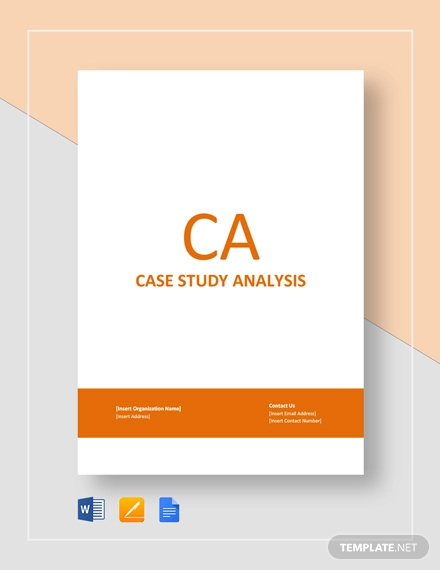
- Google Docs
Medical Case Study Template
Medical ethics case study.
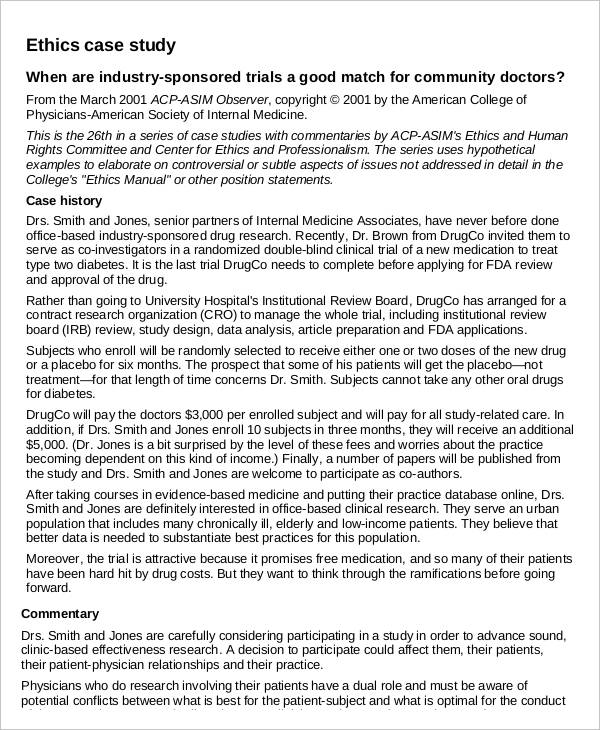
Nursing Case Study Sample
Nursing care case study.
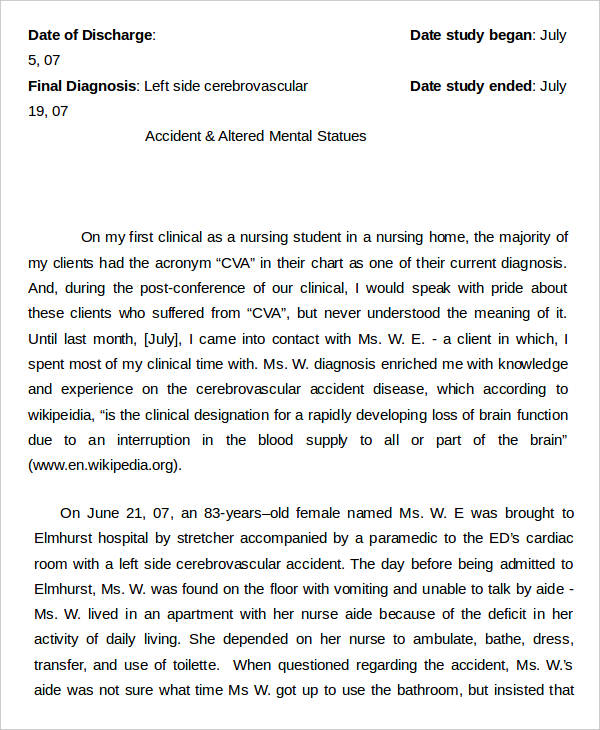
General Guidelines in Writing a Case Study
- Prepare the needed documents for your case study. Before structuring and outlining your case study, you need to plan and prepare first some documents, reports, or other resource materials that are needed in the execution of the case study.
- Starting your case study with an outline. Draft first the important sections that you should include in your case study. Free case study templates can show how are headers and sub-headers are written and effectively positioned in a case study.
- Check for deficiencies and gaps. After drafting the outline and providing the initial content of your case study, you have to read it again or let a third person read it to gain constructive criticisms as to how you can improve your outline and content.
Business Case Study Templates
Case study for international business.
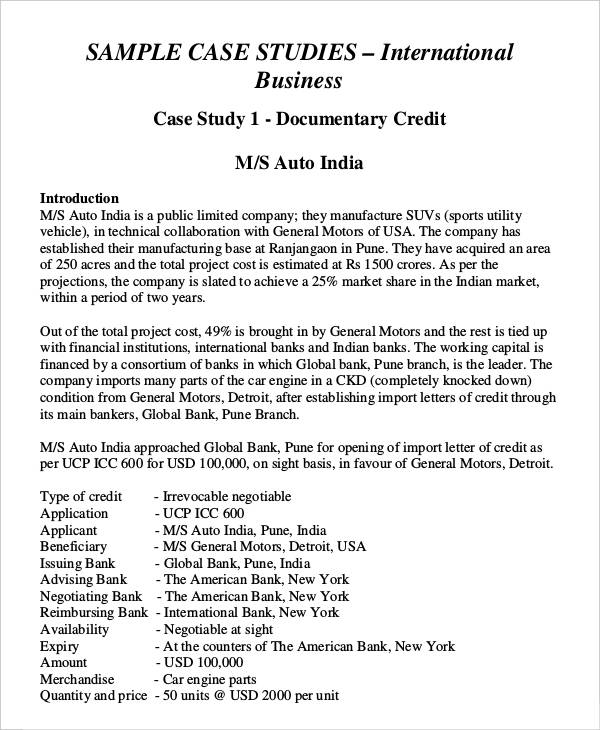
Small Business Case Study
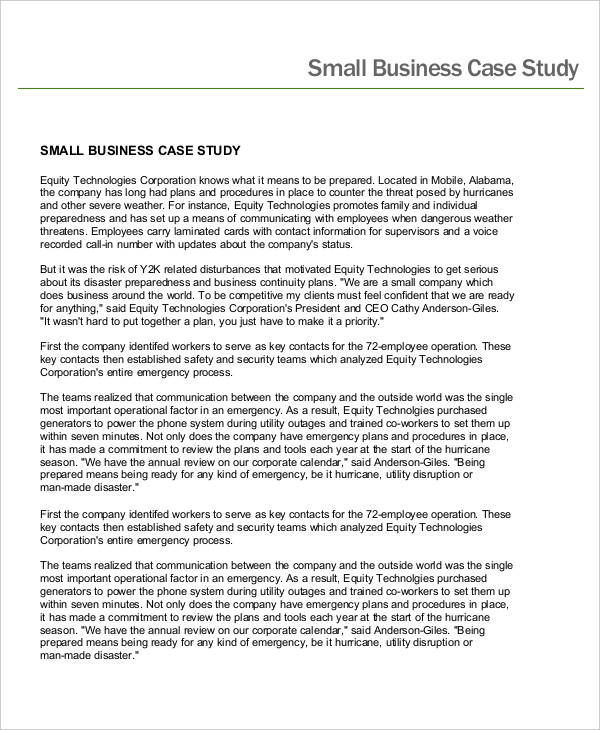
Case Study for Business Intelligence

Business Communication Case Study
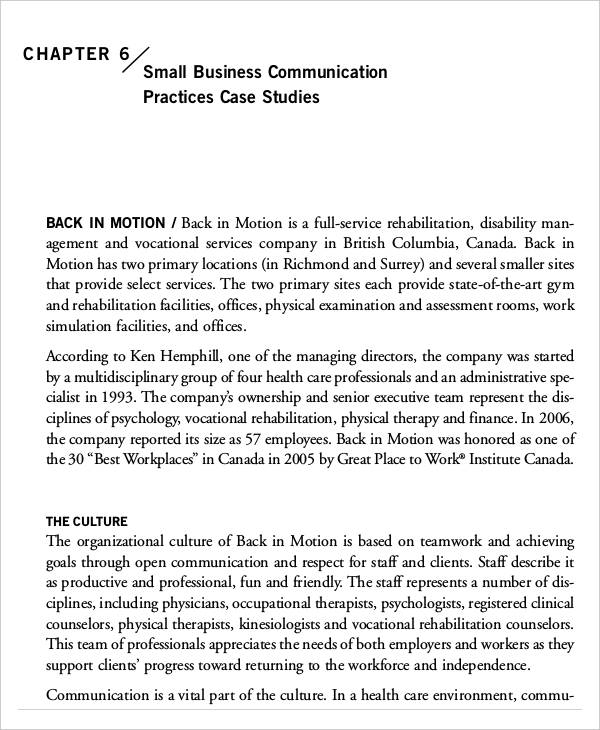
Psychology Case Study Templates
Educational psychology case study.

Case Study in Abnormal Psychology
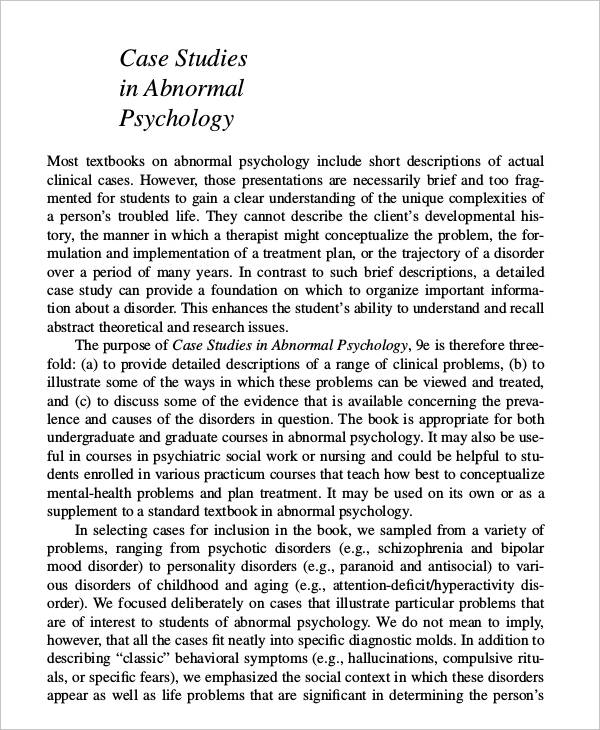
Types of Case Study Templates
- Medical Case Study Templates – According to research, most medical case studies are used to document and analyze certain clinical conditions and diseases and ultimately examining their respective treatment procedures. There are various approaches to this because clinical conditions vary from person to person. These templates will give you an idea on how medical case study works and what are the commonly used objectives and thesis statements.
- Business Case Study Templates – For business graduates, business case studies are not new to them. This is because business schools include business case studies in their lessons so as to give the students a realistic and clear picture on how business theories and strategies are applied. The offered sample templates here are applicable to international and small businesses.
- Psychology Case Study Templates – The heart of psychological case studies is centered on the intrinsic and extrinsic factors that may affect the behavior and responses of certain individuals, groups, or other occurrences. The samples can give you a hand in ensuring that the topic and outline of your case study are relevant and timely.
- Marketing Case Study Templates – Marketing case studies are considered as an effective marketing reference and tool. Advertisers and marketing officers can learn a lot from case studies in coming up with marketing strategies and plans. For those who are into the field of marketing, these case study templates can help a lot especially when the subject matters involve digital marketing, tourism, and many more.
- Financial Case Study Templates – Even in the field of numbers and financial accounts, case studies play a role. Because financial case studies deal with particular subjects following a certain case analysis format , the results can shed salient conclusions and propositions to enhance a particular financial plan or strategy.
Marketing Case Study Samples
Digital marketing case study.
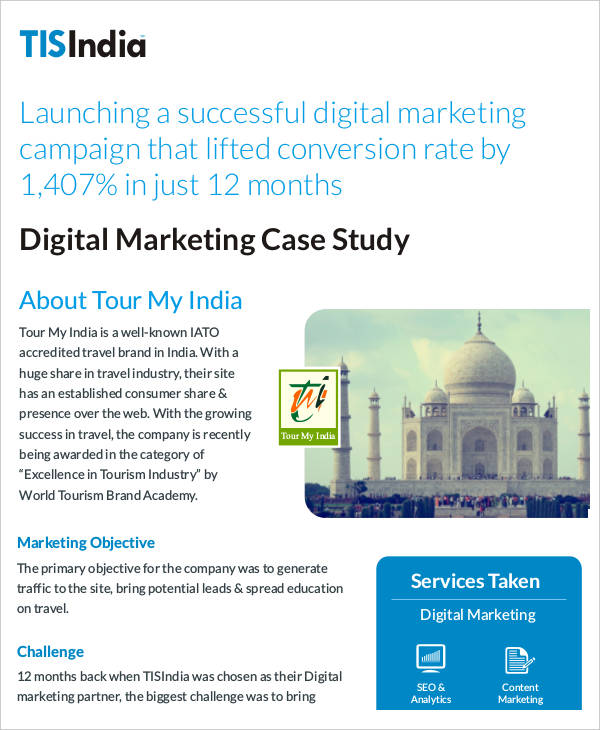
Case Study for Tourism Marketing Strategy
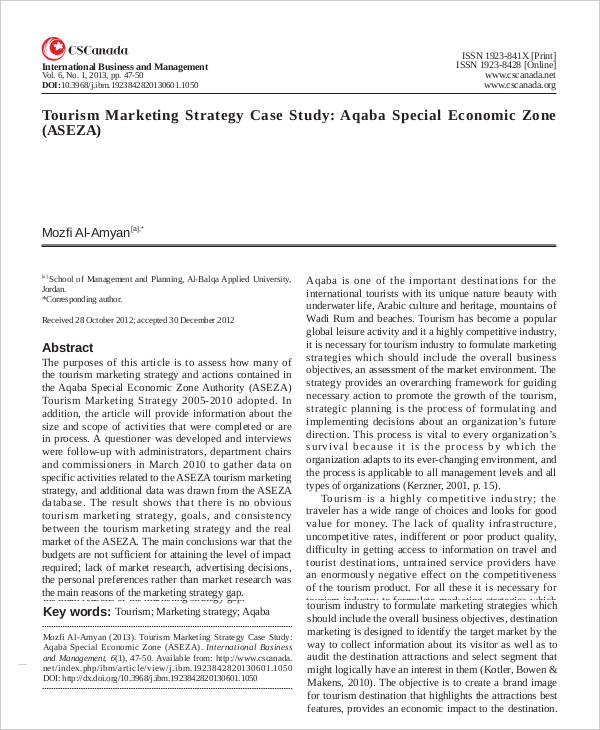
Marketing Plan Case Study
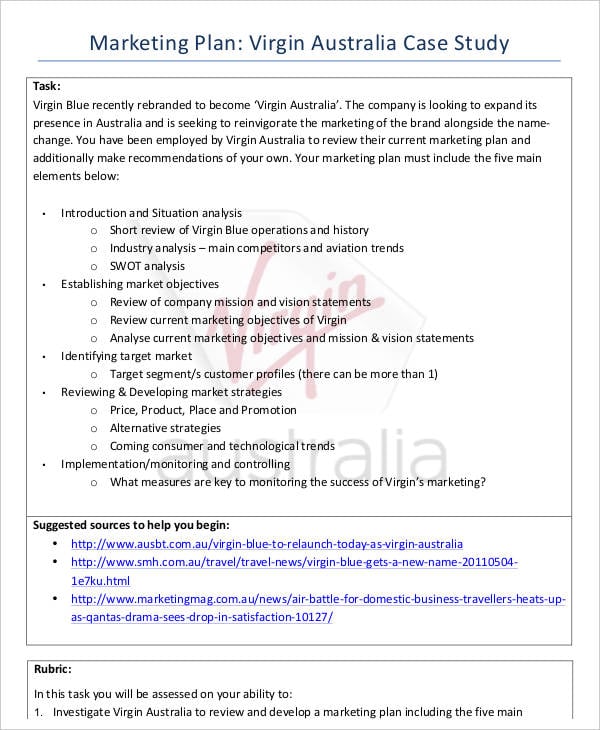
Project Case Study Templates
Case study for construction project management.
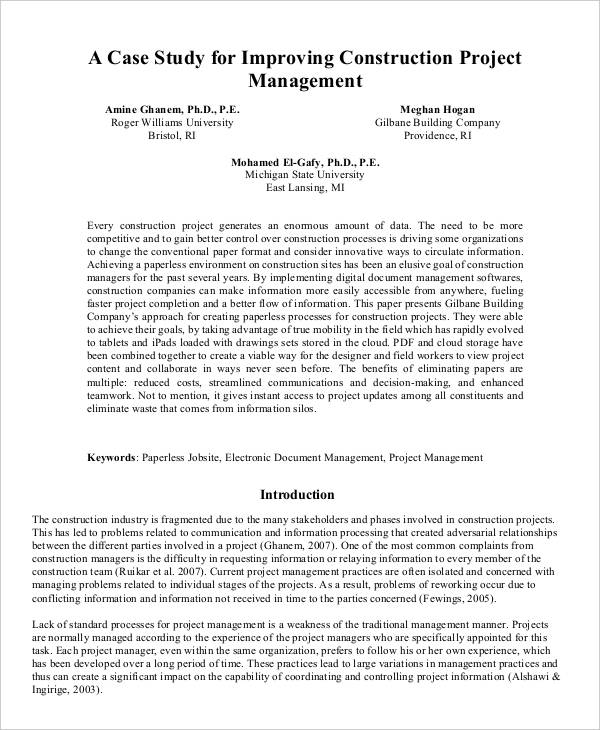
Project Failure Case Study
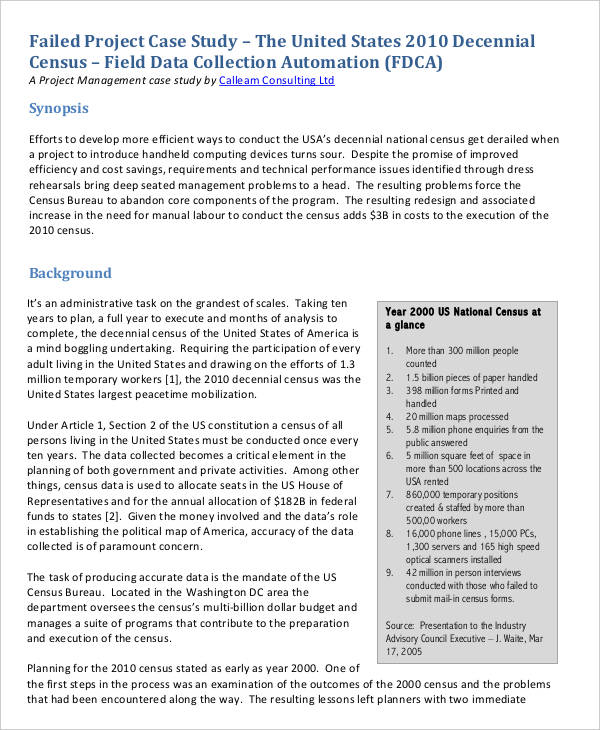
Case Study for Project Management
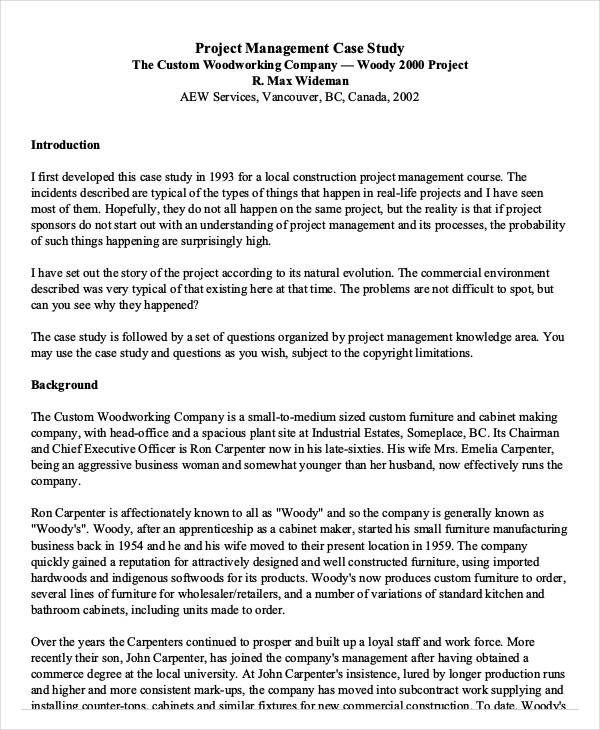
Social Case Study Templates
Case study for social worker’s mental health.

Social Media Case Study
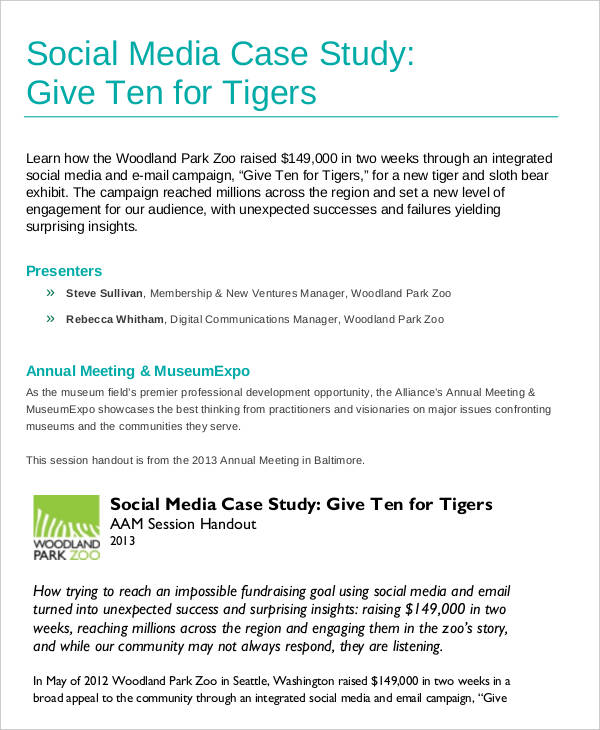
Customer Case Study Templates
Case study for customer service.
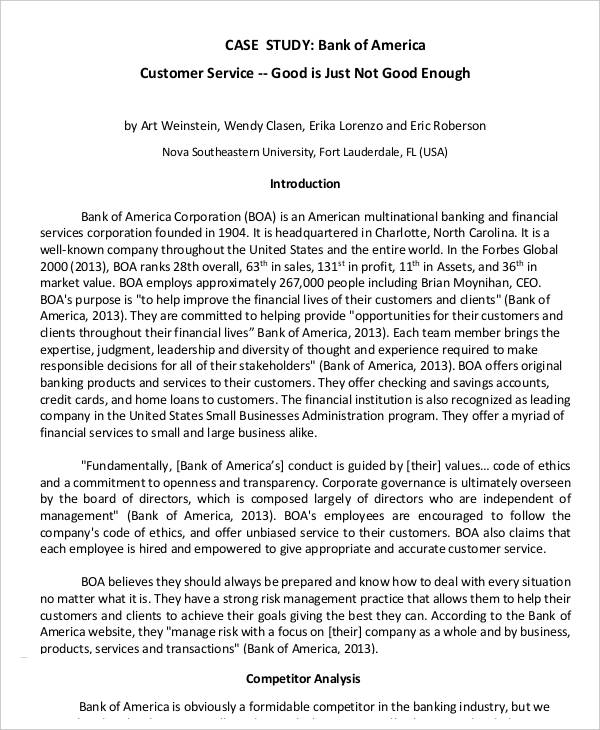
Case Study for Customer Satisfaction
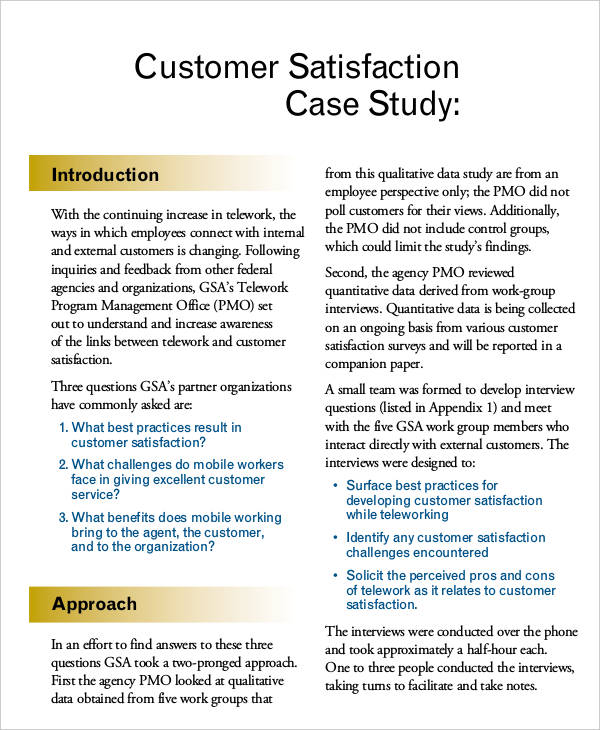
Design Case Study Templates
Graphic design case study.
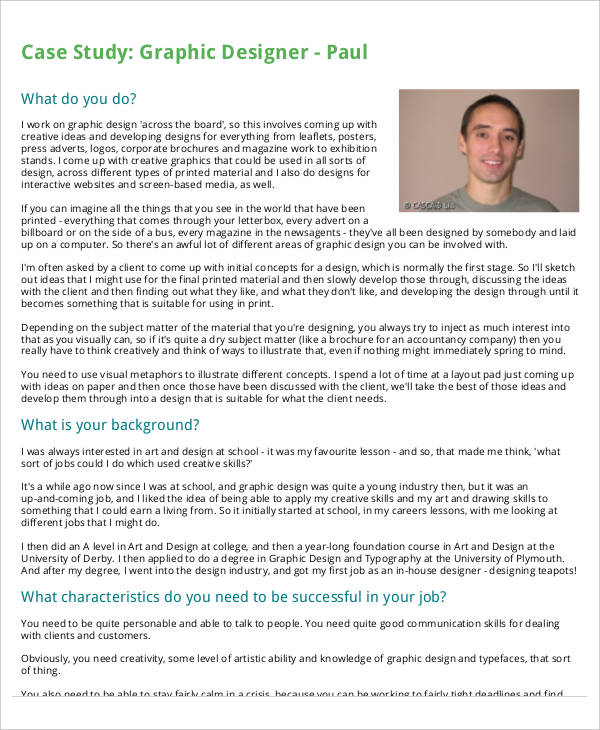
Case Study for Interior Design

Standard Inclusions of a Case Study
- Executive Summary – The executive summary is an avenue for you to give the readers of the case study an overview and summary as to the purpose and direction of the study. In here, you need to provide the field of research you’re focusing on and the corresponding methodologies and theories that you’re integrating in the study. Executive summaries are mostly present in marketing case study templates .
- Data Presentation – You need to present the findings of your case study. Test case templates can show you how the findings are structured in an engaging and professional way. You need to identify here the core problems of your case and the subject matters of your analysis and discussion.
- Discussion and Analysis – A case study is not just a mere descriptive study of a certain topic, the presented data must be digested, analyzed and correlated with one another as what is showcased by case analysis templates . Your analysis can lead you to finding the solutions to the problem or subject matter of the case study.
Financial Case Study Templates
Financial planning case study.
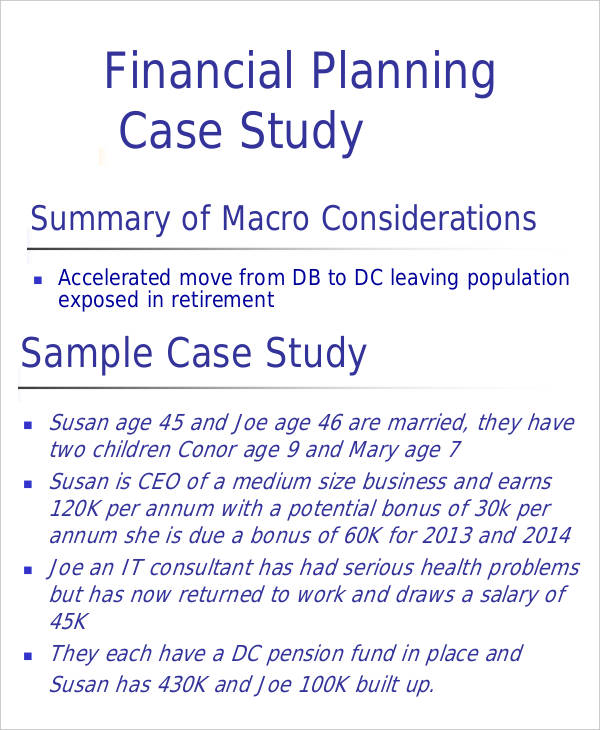
Financial Accounting Case Study
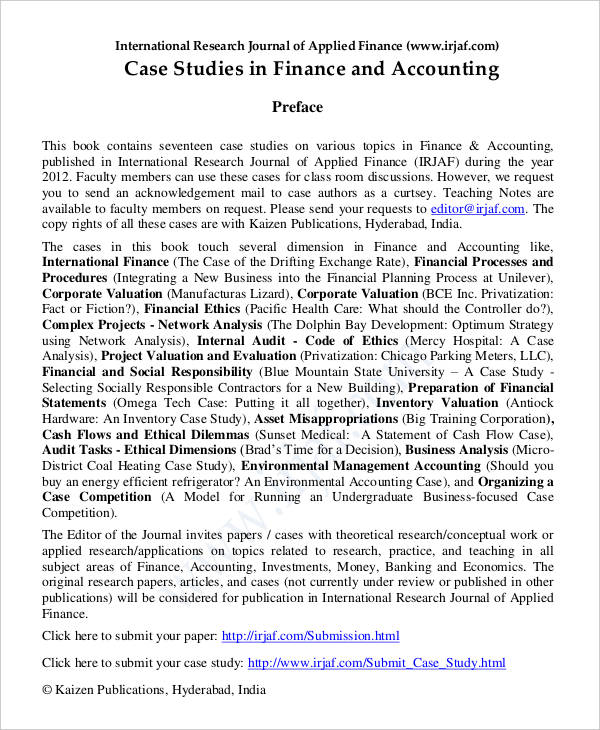
Case Study for Financial Analysis
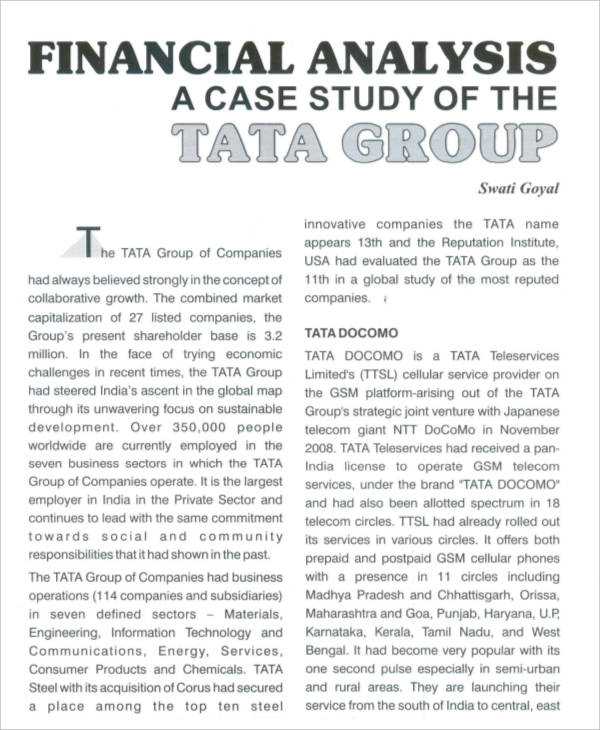
Product Case Study Templates
Case study of new product launch.
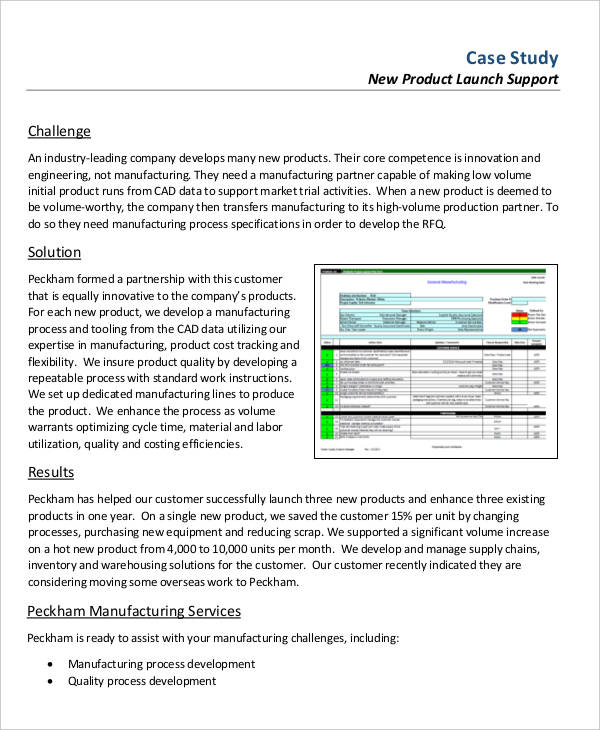
Case Study of New Product Development

Research Case Study Templates
Case study of qualitative research.
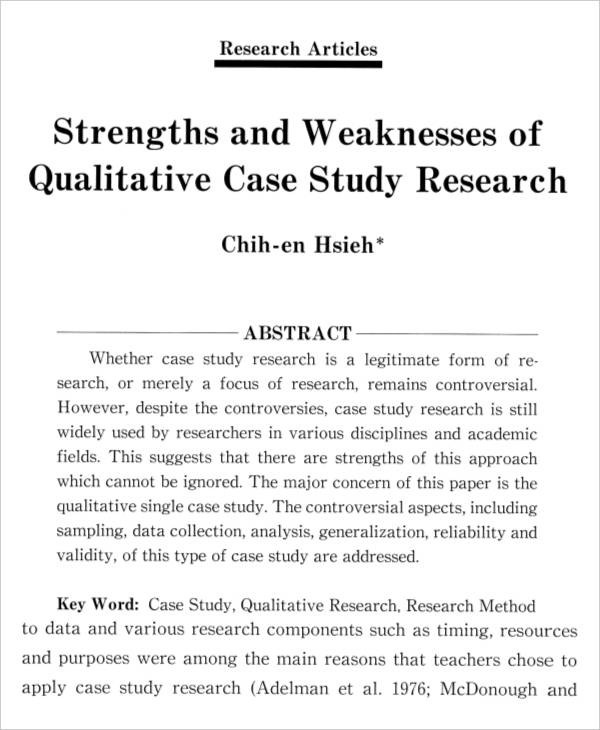
Action Research Case Study
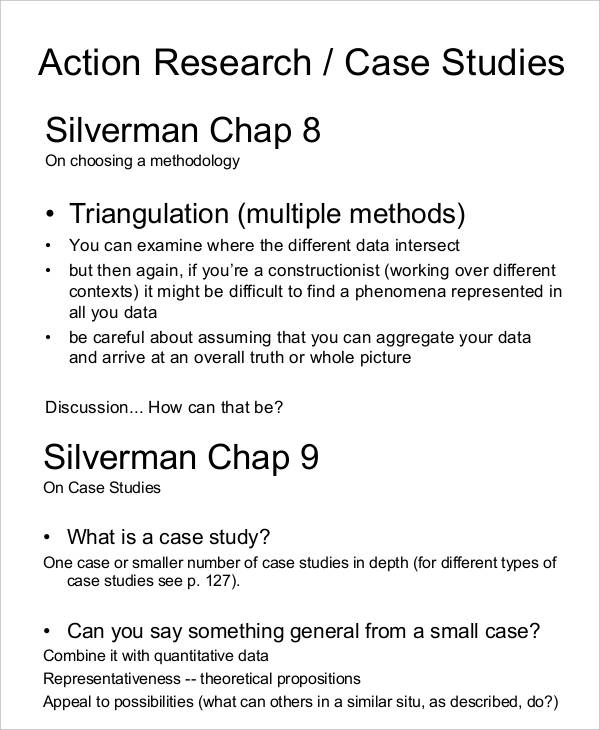
Case Study for Research Methodology
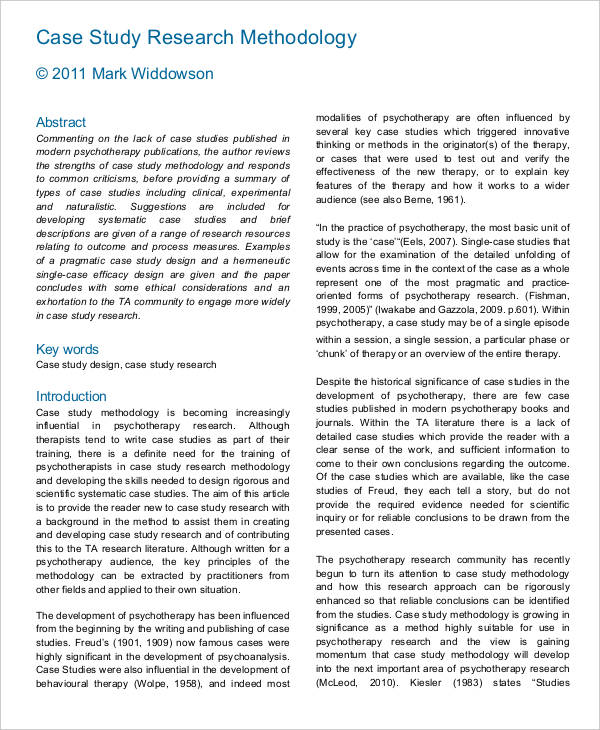
Research Proposal Case Study
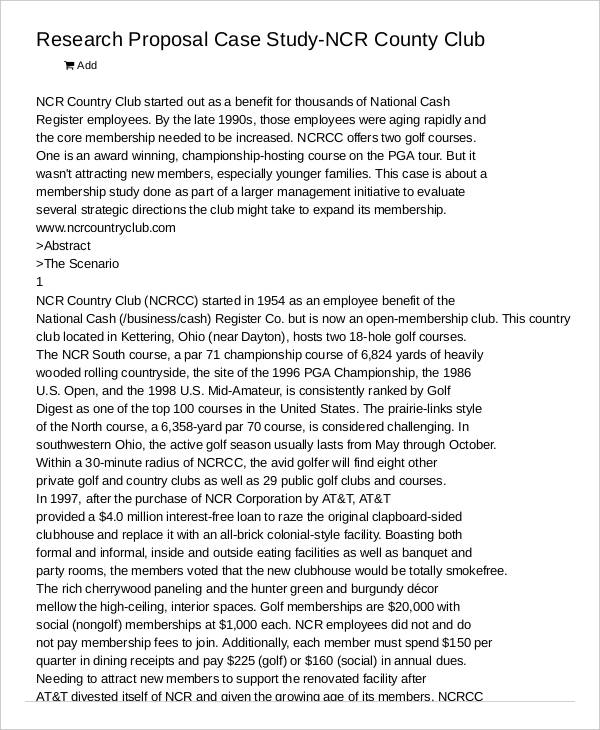
Student Case Study Templates
Case studies for disruptive student behavior.

Case Study of Nursing Student

Training Case Study Samples
Training case study.
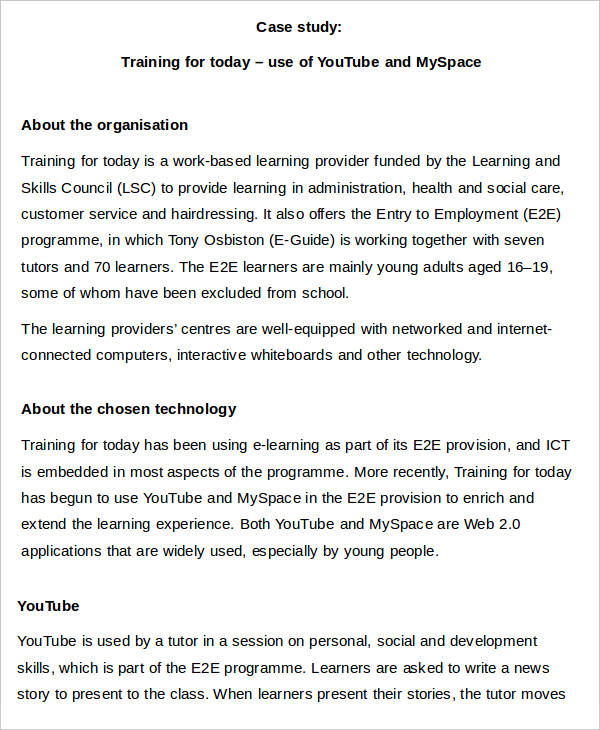
Internet Training Case Studies
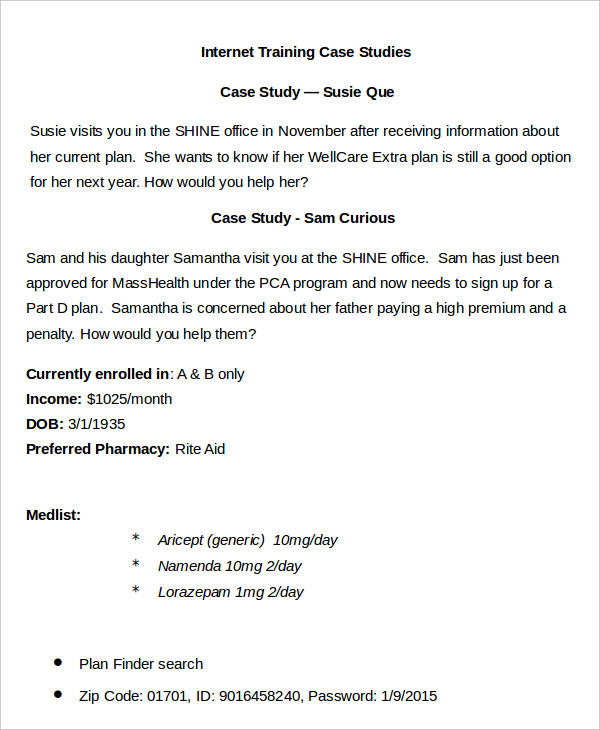
Training Case Study for Web

Invigilator Training Case Studies
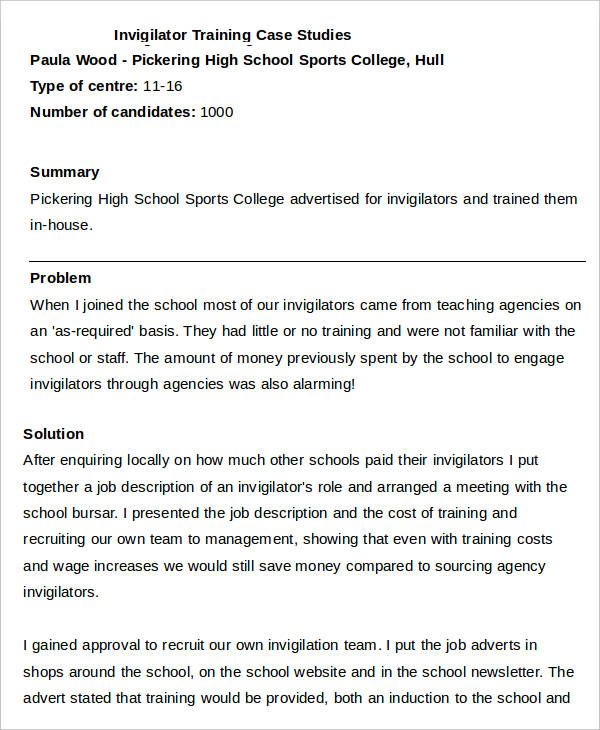
Leadership Training Case Study
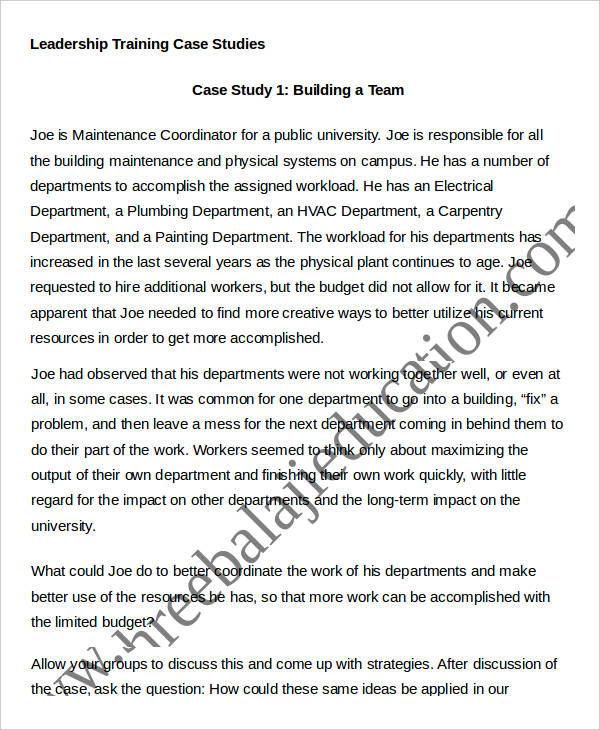
Technical Case Study Templates
Technical case study.
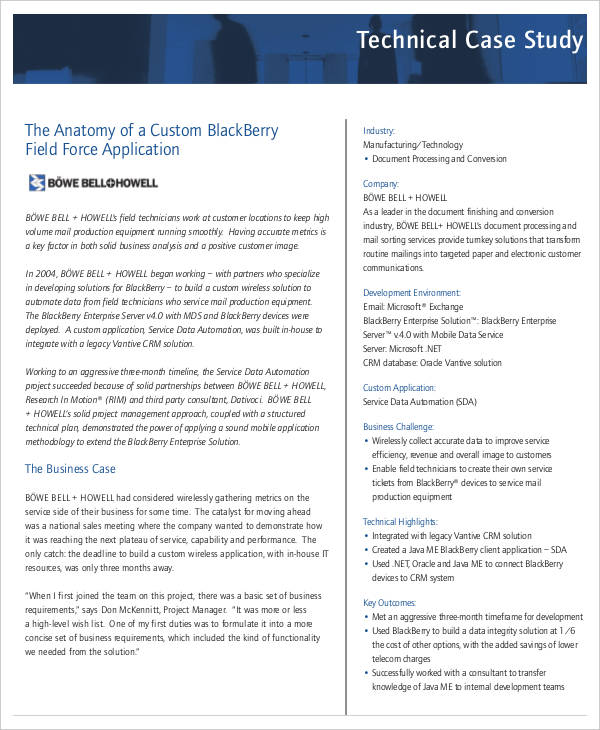
How to Create a Comprehensive and Well-written Case Study?
- Consider current field-related problems and trends. Case studies are interesting when it deals with frequently questioned subject matters, gray areas, trending issues and many more. However. Historical problems are also appealing depending on the preferences of your target audience.
- Come up with a holistic case study. In writing your case study, you should not left your readers hanging. The story should be complete and holistic. All the outlined objectives must be sufficed. That is why selecting the scope and objectives of your study is critical. Free case templates tell a complete storyline from the background of the case until its recommendations.
- Cite your references accordingly. Plagiarism and claiming other people’s work as your own are considered cardinal violations. Citing your references appropriately and consistently, one the one hand, shows professionalism.
- Make it easy to read and comprehend. The language used in your case study must be suitable to your subject audience.
More in Case Templates
Case study for students template, business case study template, education case study template, case study outline template, case study format template, social work case study template, one page case study template, nursing case study template, case study layout template.
- 12+ Case Study Examples
- FREE 10+ Case Study Release Form Templates in PDF | MS Word
- FREE 10+ Nursing Case Study Templates in PDF | MS Word
- 10+ Business Case Study Templates in PDF | DOC
- 7+ Case Study Report Templates in Google Docs | PDF | DOC | Pages
- 8+ Case Study Analysis Templates
- 31+ Case Study Samples – Word, PDF
- 18 Use Case Templates in Word
- 9+ Use Case Templates
- 9+ Business Case Templates in Word
- FREE 10+ Business Case Templates in PDF
- 10+ Sample Case Study Templates
- 9+ Free Case Templates
- 29+ Business Case Templates
File Formats
Word templates, google docs templates, excel templates, powerpoint templates, google sheets templates, google slides templates, pdf templates, publisher templates, psd templates, indesign templates, illustrator templates, pages templates, keynote templates, numbers templates, outlook templates.
- Content Writing Services
- Get in Touch
Case Study Layout: 6 Design Elements and How to Make Them Pop
Updated March 2024: Without a smart case study layout and design elements, no one will read your case study or engage with it. You need the expertise of a designer to grab and keep the reader’s attention.
In this post, we’ll explore 6 case study layouts and design elements you need to include in your next case study. This is the 6th post in a 7-part series on case study best practices .
Case study layout does more than just pretty up a page
Once you’ve figured out the case study components you want to use, then it’s time to work with your designer to figure out a case study layout and design elements that will make your story pop.
Done well, a strong case study layout and design elements will:
- highlight key statistics, facts or quotes
- increase readability by providing breaks for the eyes and mind
- use visuals to explain processes or impacts
- boost credibility and trustworthiness
- break complex topics into digestible morsels
Carefully applied color, headers, subheads, bolded text and bulleted lists should be part of every case study.
6 case study layout and design elements to include
Here are 6 other case study layout elements to consider—you should include at least some of these:
1. Add testimonials (with headshots) to your case study layout
Using callouts or pull quotes is the most popular graphic to include in case studies, according to our 2024 survey of 115 customer marketers. Great callouts or pull quotes usually take the form of a customer testimonial. A great quote is a credible third-party review of what you do. Showcase it!
Select the best sound bites from your interview to use as callouts or pull quotes. They should be informative and substantial, but not more than a sentence or two. And don’t be afraid to splice together two fragments into one killer quote (but make sure you run the final version by the interviewee). Be sure to include attribution with all quotes.
And don’t forget to include a headshot with your testimonials. It will deliver instant trustworthiness and credibility. Unfortunately, testimonials are invented fairly regularly by less scrupulous companies, so adding your customer’s face, name, job title and company to the testimonial helps it carry more weight.
Also, readers relate to people. You’ve worked to humanize the customer experience by telling a relatable, candid story in your case study. Hammer it home with a quality headshot. Don’t accept a selfie or a photo from a wedding. Headshots must be on-brand, personable, professional and do both you and your customer justice.
Here’s a sample of a headshot from our own website:
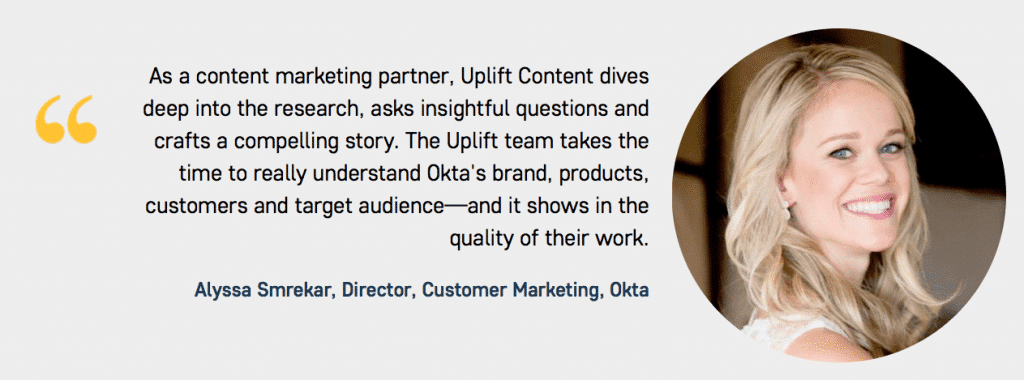
And here’s another sample from HR software company Zenefits’ case study on its customer, Skilljar:

2. Include strong metrics in your case study layout
Metrics are the third most popular graphic to include in your case studies, but we also know that identifying impactful metrics for case studies is a big challenge.
So, if you ARE able to get some compelling metrics, be sure to showcase them near the top of your case study.
Here’s a simple but effective example of a metrics block from Databricks :

And here’s a cool metrics block from Flock Freight :
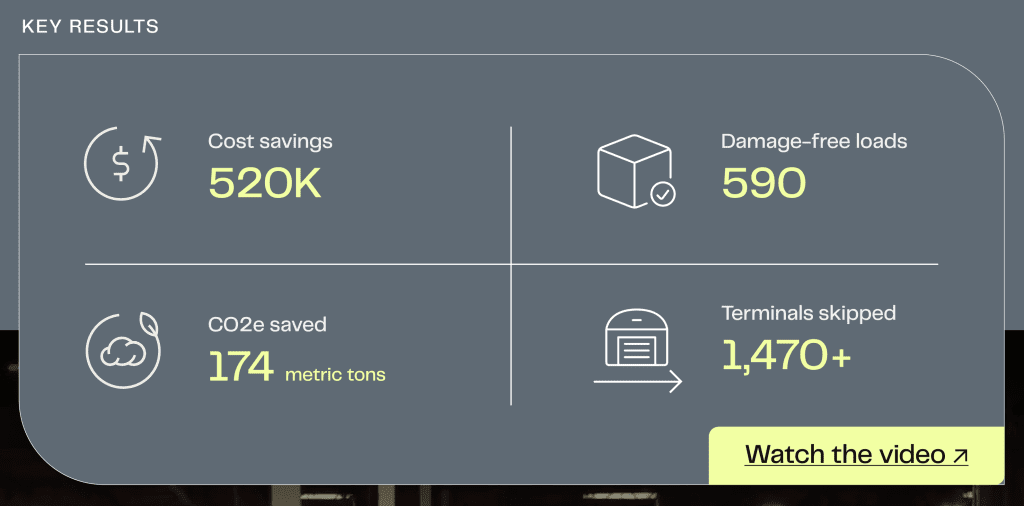
3. Use workplace photos in your case study layout and design elements
If possible or relevant, include other photos from the customer’s workplace. This can help the reader understand the type of industry, work processes and standards of the customer. Vast libraries of stock photos are available if you’re stuck—but your own pictures will be better and tell the story more honestly.
This workplace photo from an Expensify case study on Philz Coffee helps readers quickly understand some of the context of the story.

This product shot from a ServiceChannel case study on FreshPet also helps readers visually connect with the story.

4. Include data illustrations to enhance your case study layout
Some readers are visual. The best case study layout samples include clear data illustrations with minimal text, which are more effective than a paragraph full of numbers. Experiment with the best way to showcase the statistics or data you have. Examples include:
ClickUp uses screenshots and graphics to help readers understand what the solution looks like:
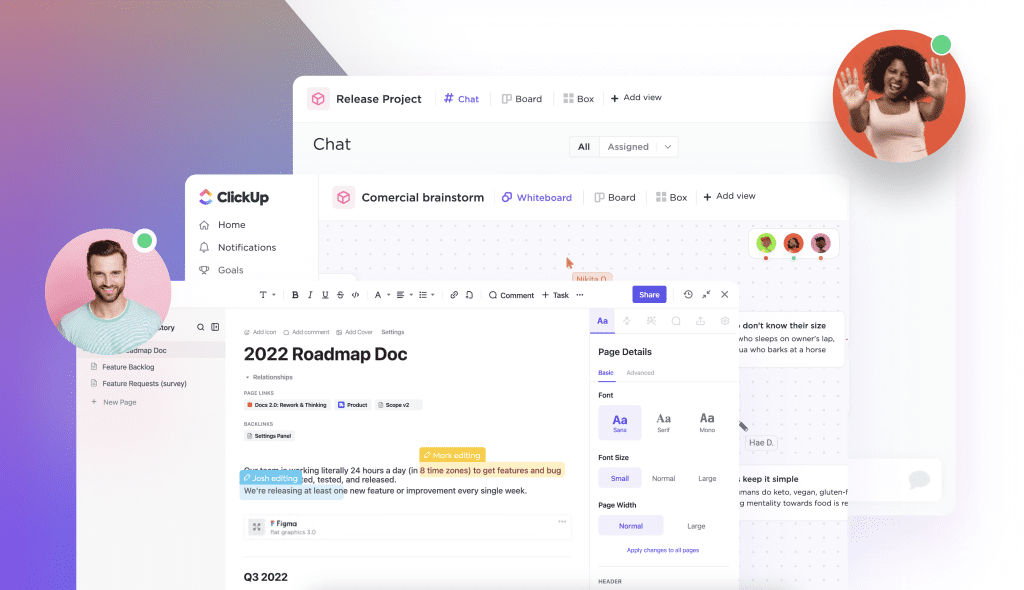
Imprivata (formerly Fairwarning) uses helpful graphics like this to clarify relational information in a visual way:

5. Add informative infographics to your case study layout and design elements
Infographics visually break down a complex process into simple steps, or help guide the reader through the highlights of your case study.
Some elements of a case study may lend themselves to infographics more than others. If you think this may be the case, talk to an experienced designer. Translating words into a compelling graphic is an art.
Infographics are currently underused —only 19% of respondents include them as a case study format—but another 39% plan to try infographics this year .
Here are two great samples of infographics from Splunk’s case study on Domino’s Pizza:
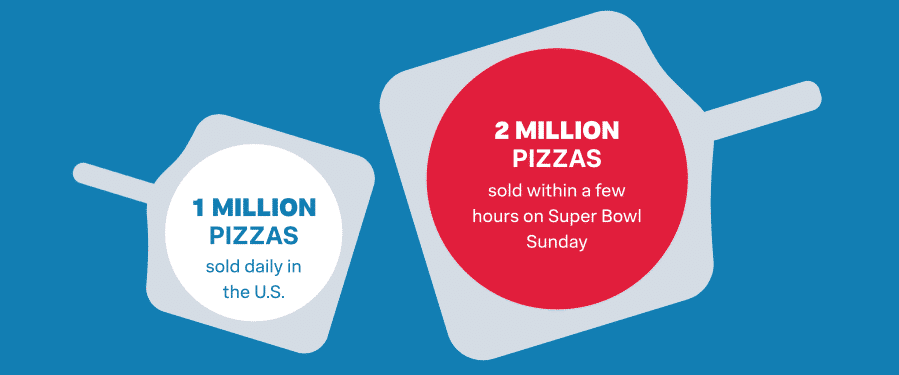
6. Finish your case study layout with a compelling call to action
If you’ve held your reader’s attention until the end of your case study, they’re likely interested in learning more about your products and services. Consider including a “Read more stories” or “Watch a demo” call to action (CTA) at the bottom of your case study layout. Make sure your case study CTA stands out from the text in your case study by using large fonts, colors and graphic elements like boxes or lines.
Here’s an example from Flock Freight that illustrates how this CTA element could look:

Here’s another example of a CTA from Waldo , which offers readers two avenues to explore next:

Case study layout is important, but keep the focus on the story
Remember, although the visual elements of a case study template should be strong, the text is still the main feature of your case study. You should use case study layout and design elements to pull the reader through the story, highlight key points and make for an easier reading experience. Don’t let the case study layout and design elements overwhelm the reader.
You’re swamped. We’re here to help.
Check out our B2B SaaS case study writing services . We work with high-growth companies like Okta and WalkMe to create powerful case studies that nurture leads and close sales faster.

As the founder of Uplift Content, Emily leads her team in creating done-for-you case studies, ebooks and blog posts for high-growth SaaS companies like ClickUp, Calendly and WalkMe. Connect with Emily on Linkedin
Sign up for the Content Huddle newsletter
Learn from Emily’s 17 years of aha moments, mistakes, observations, and insights—and find out how you can apply these lessons to your own marketing efforts.
You can unsubscribe any time. Visit our Terms of Use for information on our privacy practices.

Case Study Template Clean & Professional Report Template that is can be used for any type of Corporate and fully editable and customizable. This layout is suitable for any project purpose. Very easy to use and customize. Simply add your own images and text
Included in this set:
- Easy Customizable and Editable
- Vector EPS and PSD
- Dimension: A4, 8.27”x11.69” Inch Bleed (0.25 inch)
- CMYK Color, 300 DPI
- Print Ready Format
- Free font (download link the help file)
Files Include:
- Adobe Illustrator (.eps)
- Adobe Photoshop (.psd)
- Help File (.txt)
The images & Mockups presented in the preview are for illustrative purposes only and are not included in the download
Zipped File Size: 1.86 MB
File Types Included: AI, PSD
Software Compatibility: Adobe Illustrator CC 2018 (and higher), Adobe Photoshop CC 2018 (and higher).
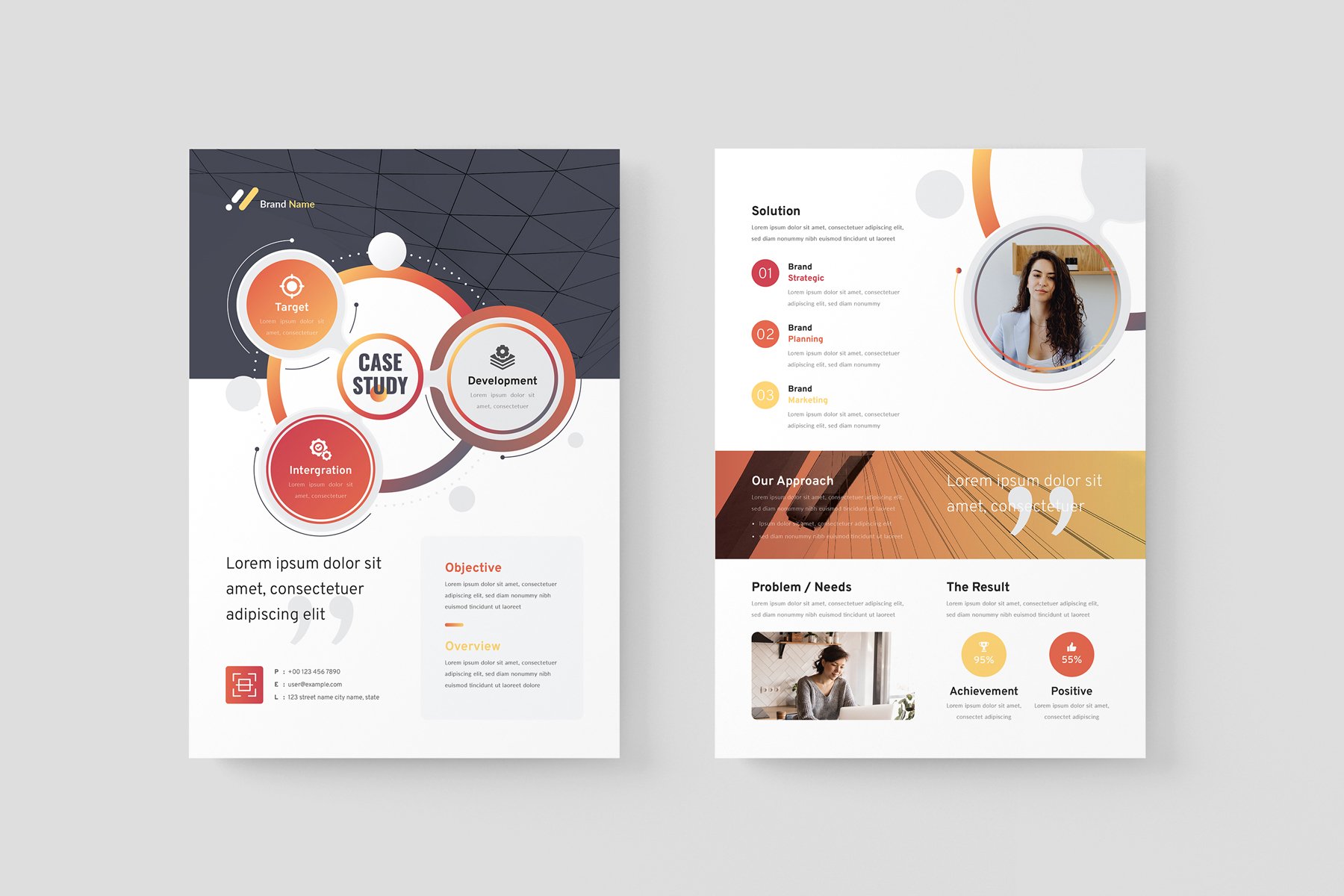
- Flyer/Brochure Templates
Extended Licence Included for personal & commercial projects
Professional Support from our helpful team
Frequently Bought Together
We think you’ll also love…, be the first to review “case study” cancel reply.
Your email address will not be published. Required fields are marked *
Why Design Cuts is The Smart Choice For Designers
Huge savings when you buy two or more marketplace items
At no extra cost , covering commercial & products for resale! Click for details
Contact our friendly Customer Support Team at any time for help or advice
Our downloads don't expire! Download what you need, when you need it
Conceptual Design of Green Filters: A Case Study of Libertador Bolívar
- Conference paper
- First Online: 30 April 2024
- Cite this conference paper

- Jairo Dueñas-Tovar ORCID: orcid.org/0000-0002-3232-4611 4 , 5 ,
- Paúl Carrión-Mero ORCID: orcid.org/0000-0002-3581-5774 4 , 6 ,
- Jorge Loor-Salazar 4 ,
- Alex Quiguango-Aráus 4 &
- Fernando Morante-Carballo ORCID: orcid.org/0000-0003-0374-0306 5 , 6 , 7
Part of the book series: Environmental Science and Engineering ((ESE))
Included in the following conference series:
- International Conference on Energy and Environment Research
The water supply is vital for the development of human activities. However, wastewater generated must be adequately treated or reused, so applying an adequate and environmentally friendly purification method is necessary. In Ecuador, Libertador Bolívar coastal community presents frequent overflows of wastewater from the stabilization ponds due to mass tourism, being a challenge for the administrators of the local sanitary network. This research aims to carry out a geomechanical characterization of the soils of the sector through field studies and laboratories to obtain an optimal location of green filter systems that reduce contamination by wastewater discharges that generate an environmental problem. The results showed that the lithology of the area (sands with a high clay content) allows adequate filtration to remove and reduce the concentration of pathogenic microorganisms in the pre-treated waters in the stabilization ponds. Simultaneously, a timber species ( Guadua angustifolia ) was proposed due to an affinity to humid environments, accelerated growth and final use as building construction materials. According to these results, an approximate area of 15.46 ha is suggested around the stabilization ponds for the maximum reuse of residual water, contributing to the sustainable development of the affected population and generating an economic resource in the sustainable use of timber resources.
This is a preview of subscription content, log in via an institution to check access.
Access this chapter
- Available as PDF
- Read on any device
- Instant download
- Own it forever
- Available as EPUB and PDF
- Durable hardcover edition
- Dispatched in 3 to 5 business days
- Free shipping worldwide - see info
Tax calculation will be finalised at checkout
Purchases are for personal use only
Institutional subscriptions
Agency JAE (2007) ALOS PALSAR Digital Elevation Model. https://asf.alaska.edu/data-sets/sar-data-sets/alos-palsar/
Ahmed M, Mavukkandy MO, Giwa A, et al (2022) Recent developments in hazardous pollutants removal from wastewater and water reuse within a circular economy. npj Clean Water 5:12. https://doi.org/10.1038/s41545-022-00154-5
Alvarez Vega F (2002) Filtros verdes. Un sistema de depuración ecológico. Ing Hidráulica y Ambient 23:
Google Scholar
Beesley L, Marmiroli M (2011) The immobilisation and retention of soluble arsenic, cadmium and zinc by biochar. Environ Pollut 159:474–480. https://doi.org/10.1016/j.envpol.2010.10.016
Article Google Scholar
Ebel BA, Moody JA (2013) Rethinking infiltration in wildfire-affected soils. Hydrol Process 27:1510–1514. https://doi.org/10.1002/hyp.9696
Elgallal M, Fletcher L, Evans B (2016) Assessment of potential risks associated with chemicals in wastewater used for irrigation in arid and semiarid zones: A review. Agric Water Manag 177:419–431. https://doi.org/10.1016/j.agwat.2016.08.027
Fahd K, Martín I, Salas JJ (2007) The Carrión de los Céspedes Experimental Plant and the Technological Transfer Centre: urban wastewater treatment experimental platforms for the small rural communities in the Mediterranean area. Desalination 215:12–21. https://doi.org/10.1016/j.desal.2006.10.034
Food and Agriculture Organization (FAO) 9. Soil Permeability. https://www.fao.org/fishery/docs/CDrom/FAO_Training/FAO_Training/General/x6706e/x6706e09.htm . Accessed 17 Jun 2023
GAD Parroquial Manglaralto (2019) Plan de Desarrollo y Ordenamiento Territorial de Manglaralto 2019–2023
Grundmann J, Schütze N, Schmitz GH, Al-Shaqsi S (2012) Towards an integrated arid zone water management using simulation-based optimisation. Environ Earth Sci 65:1381–1394. https://doi.org/10.1007/s12665-011-1253-z
Karkush MO, Al-Taher TAA (2017) Geotechnical Evaluation of Clayey Soil Contaminated with Industrial Wastewater. Arch Civ Eng 63:47–62. https://doi.org/10.1515/ace-2017-0004
Kasak K, Truu J, Ostonen I et al (2018) Biochar enhances plant growth and nutrient removal in horizontal subsurface flow constructed wetlands. Sci Total Environ 639:67–74. https://doi.org/10.1016/j.scitotenv.2018.05.146
Kumar V (2019) A Review on Influence of Sewage Water on Soil Properties and Microbial Biomass Carbon. Int J Pure Appl Biosci 7:83–90. https://doi.org/10.18782/2320-7051.7809
Liu C, Liu F, Andersen MN et al (2021) Domestic wastewater infiltration process in desert sandy soil and its irrigation prospect analysis. Ecotoxicol Environ Saf 208:111419. https://doi.org/10.1016/j.ecoenv.2020.111419
Loor Salazar JA, Quiguango Aráus AA (2021) Caracterización geomecánica de suelos para su aplicación en el diseño de filtros verdes, en las comunas Montañita y Libertador Bolívar. Escuela Superior Politécnica del Litoral (ESPOL)
Merchán-Sanmartín B, Carrión-Mero P, Suárez-Zamora S et al (2022b) Sanitary Sewerage Master Plan for the Sustainable Use of Wastewater on a University Campus. Water 14:2425. https://doi.org/10.3390/w14152425
Merchán-Sanmartín B, Aguilar-Aguilar M, Morante-Carballo F, et al (2022) Design of Sewerage System and Wastewater Treatment in a Rural Sector: A Case Study. Int J Sustain Dev Plan 17:51–61. https://doi.org/10.18280/ijsdp.170105
Morante Carballo F, Brito Marcatoma L, Carrión Mero P, et al (2019) Urban wastewater treatment through a system of green filters in the Montañita commune, Santa Elena, Ecuador. pp 233–249
Muñoz-López J, Camargo-García JC, Romero-Ladino C (2020) Valuation of ecosystem services of guadua bamboo (Guadua angustifolia) forest in the southwestern of Pereira, Colombia. Caldasia 43:186–196. https://doi.org/10.15446/caldasia.v43n1.63297
Navas-Cárdenas C, Caetano M, Endara D et al (2023) The Role of Oxygenated Functional Groups on Cadmium Removal using Pyrochar and Hydrochar Derived from Guadua angustifolia Residues. Water 15:525. https://doi.org/10.3390/w15030525
Oladoja NA, Ademoroti CMA (2006) The use of fortified soil-clay as on-site system for domestic wastewater purification. Water Res 40:613–620. https://doi.org/10.1016/j.watres.2005.11.031
Ouyang L, Wang F, Tang J et al (2013) Effects of biochar amendment on soil aggregates and hydraulic properties. J soil Sci plant Nutr. https://doi.org/10.4067/S0718-95162013005000078
Parrales Gómez MM, Pozo Ramos EL (2019) Tratamiento de aguas residuales urbanas mediante un sistema de filtros verdes en la Comuna Libertador Bolívar. Escuela Superior Politécnica del Litoral (ESPOL)
Pereira L, Trout T (1999) Irrigation Methods. In: CIGR Handbook of Agricultural Engineering. American Society of Agricultural Engineers, pp 297–379
Pereira LS, De Juan JA, Picornell MR, Tarjuelo JM (2010) El riego y sus tecnologías. CREA-UCLM, Albacete
Quege KE, Almeida RDA, Ucker FE (2013) Utilização de plantas de bambu no tratamento de esgoto sanitário pelo sistema de alagados construidos. Rev Eletrônica em Gestão, Educ e Tecnol Ambient 10. https://doi.org/10.5902/223611707440
Subsecretaría de Saneamiento Ambiental y Obras Sanitarias, IEOS (1992) Código Ecuatoriano de la Construcción de parte IX Obras Sanitarias
Torres B, Segarra M, Bragança L (2019) El bambú como alternativa de construcción sostenible. Extensionismo, Innovación y Transf Tecnológica 5:389. https://doi.org/10.30972/eitt.503787
Download references
Author information
Authors and affiliations.
Facultad de Ingeniería en Ciencias de la Tierra (FICT), Escuela Superior Politécnica del Litoral, Guayaquil, Ecuador
Jairo Dueñas-Tovar, Paúl Carrión-Mero, Jorge Loor-Salazar & Alex Quiguango-Aráus
Geo-Recursos y Aplicaciones (GIGA), Escuela Superior Politécnica del Litoral, Guayaquil, Ecuador
Jairo Dueñas-Tovar & Fernando Morante-Carballo
Centro de Investigación y Proyectos Aplicados a las Ciencias de la Tierra (CIPAT), Escuela Superior Politécnica del Litoral, Guayaquil, Ecuador
Paúl Carrión-Mero & Fernando Morante-Carballo
Facultad de Ciencias Naturales y Matemáticas (FCNM), Escuela Superior Politécnica del Litoral, Guayaquil, Ecuador
Fernando Morante-Carballo
You can also search for this author in PubMed Google Scholar
Corresponding author
Correspondence to Fernando Morante-Carballo .
Editor information
Editors and affiliations.
Departamento de Engenharia Química, Instituto Superior de Engenharia do Porto, Porto, Portugal
Nídia S. Caetano
Rights and permissions
Reprints and permissions
Copyright information
© 2024 The Author(s), under exclusive license to Springer Nature Switzerland AG
About this paper
Cite this paper.
Dueñas-Tovar, J., Carrión-Mero, P., Loor-Salazar, J., Quiguango-Aráus, A., Morante-Carballo, F. (2024). Conceptual Design of Green Filters: A Case Study of Libertador Bolívar. In: Caetano, N.S. (eds) Sustainable Development with Renewable Energy. ICEER 2023. Environmental Science and Engineering. Springer, Cham. https://doi.org/10.1007/978-3-031-54394-4_26
Download citation
DOI : https://doi.org/10.1007/978-3-031-54394-4_26
Published : 30 April 2024
Publisher Name : Springer, Cham
Print ISBN : 978-3-031-54393-7
Online ISBN : 978-3-031-54394-4
eBook Packages : Engineering Engineering (R0)
Share this paper
Anyone you share the following link with will be able to read this content:
Sorry, a shareable link is not currently available for this article.
Provided by the Springer Nature SharedIt content-sharing initiative
- Publish with us
Policies and ethics
- Find a journal
- Track your research

COMMENTS
A case study is a detailed analysis of a specific topic in a real-world context. It can pertain to a person, place, event, group, or phenomenon, among others. The purpose is to derive generalizations about the topic, as well as other insights. Case studies find application in academic, business, political, or scientific research.
14 Case Study Templates. Now that we have explored some of the high level strategies you can use to create a business case study, we will transition to 14 case study design templates you can use with Visme. 1. Fuji Xerox Australia Case Study Template. Customize this template and make it your own!
Modern design deck template with multiple sections. Learn more. Visual portfolio template. Modern visual portfolio template with 12 column grid and light and dark themes. ... Case study presentation template complete with project overview, wireframes and key journey insights. Learn more.
Case study examples. While templates are helpful, seeing a case study in action can also be a great way to learn. Here are some examples of how Adobe customers have experienced success. Juniper Networks. One example is the Adobe and Juniper Networks case study, which puts the reader in the customer's shoes.
2. Determine the case study's objective. All business case studies are designed to demonstrate the value of your services, but they can focus on several different client objectives. Your first step when writing a case study is to determine the objective or goal of the subject you're featuring.
2. Intel Case Study. This simple light-red template is perfect for tech companies looking to quickly present their case study with an overview of its background, goals, and strategy. It ends the presentation by going through the study's figures and data. Customize this template and make it your own!
Case Study template. This is a guide for designers on writing a case study. A case study is a way to showcase the impact of a design solution on a real-world problem or opportunity. It can help to demonstrate the value of a product or service to potential clients, stakeholders or interviewers.
Download now for an impactful and polished case study presentation that sets you apart. F E A T U R E S. Compatible With InDesign (INDD) Easy Edit Template. Instant Download - your files are available immediately after purchase. Professional, clean design. A4 Paper Size + 3mm bleed. 2 Pages Document. THE MOCK-UP AND PHOTOS ARE NOT INCLUDED.
Get Case Study Design Template that includes a4 & cleanstudy, from our library of Print Templates. Get unlimited downloads with an Envato Elements subscription! ... Introducing our Case Study Design Template, a powerful tool to showcase success stories. This template combines sleek design with functionality, creating a compelling narrative ...
The Case Study Layout Template is designed for effective presentation of comprehensive case analyses. It features a structured format, including sections for background, challenges, solutions, and results. With clear headings, this template facilitates a logical flow of information, ensuring a compelling narrative.
Provide Some Context. Case studies are more effective when you include some information at the beginning to set the stage. This can include things like the date of the project, name of the client, and what the client does. Providing some context will make the case study more relatable to potential clients.
2,900+ customizable design templates for 'a4 case study'. Fast. Affordable. Effective. Design like a pro. Tip: Use NOT to remove irrelevant results, use OR to add more. Create free a4 case study flyers, posters, social media graphics and videos in minutes. Choose from 2,900+ eye-catching templates to wow your audience.
Jewel Case Templates - 10+ Free Word, PDF, PSD, EPS. 14+ CD Case Templates - Word, PDF, PSD, EPS, InDesign. 10+ Free Microsoft Word Case Templates Download. Write a compelling and well-researched case study to convey and foreground the importance of your product or service. Use the case study templates to help you attain such goal.
1. Add testimonials (with headshots) to your case study layout. Using callouts or pull quotes is the most popular graphic to include in case studies, according to our 2024 survey of 115 customer marketers. Great callouts or pull quotes usually take the form of a customer testimonial. A great quote is a credible third-party review of what you do.
Use Canva's filters to quickly find the right layout based on style, theme, price, or even color scheme. Click on the report cover template of your choice to be directed to Canva's free online editor, and get started on the customization. Keep things simple by updating only the placeholder text, fonts, and colors or moving things around.
A case study is an appropriate research design when you want to gain concrete, contextual, in-depth knowledge about a specific real-world subject. It allows you to explore the key characteristics, meanings, and implications of the case. Case studies are often a good choice in a thesis or dissertation. They keep your project focused and ...
Clean, Simple, Modern, and Professional Case Study design. Fully customizable easy to use and replace color & text. Features. A4 (210×297mm) and US Letter (8.5×11 inches). Files are print ready. high resolution. 300 dpi. CMYK. Professional and clean design. Quick and easy-to-customize templates. Quick changes (INDESIGN and Ms. Word Files).
Search from thousands of royalty-free Case Study Template A4 stock images and video for your next project. Download royalty-free stock photos, vectors, HD footage and more on Adobe Stock.
Evgenystudio . 83 450. UI UX Case Study Template Free Presentation For Behance. Amr Abd Elhady. 609 29.2k. US $8. Case Study Flyer Template. Mamunur Rashid. 73 506.
A case study is one of the most commonly used methodologies of social research. This article attempts to look into the various dimensions of a case study research strategy, the different epistemological strands which determine the particular case study type and approach adopted in the field, discusses the factors which can enhance the effectiveness of a case study research, and the debate ...
Case Study Template Clean & Professional Report Template that is can be used for any type of Corporate and fully editable and customizable. ... Easy Customizable and Editable; Vector EPS and PSD; Dimension: A4, 8.27"x11.69" Inch Bleed (0.25 inch) CMYK Color, 300 DPI; Print Ready Format; ... providing the very best design resources at prices ...
The Asunta Case was created by Ramón Campos, Gema R. Neira, Jon de la Cuesta, and David Orea. Campos also directed the 2017 documentary about the case, El caso Asunta: Operación Nenúfar ...
Figure 26.1 shows a flowchart obtaining a Conceptual Design of Green Filters as a final product to achieve the proposed objective. This work involved three phases, which included: (i) Analysis of the environmental conditions of the sector, (ii) Soil Properties Assessment and (iii) System Dimension Measurement.
The main purpose of this study is to quantify and compare the embodied carbon (EC) from the materials used or designed to build the Adohi Hall, a residence building located on the University of Arkansas campus in Fayetteville, AR. It has been constructed as a mass timber structure. It is compared to the same building design with a steel frame for this study. Based on the defined goal and scope ...
The Case Study Template offers a structured format for comprehensive analysis. With dedicated sections for background, challenges, solutions, and results, it streamlines information presentation. Its succinct design ensures clarity and ease of understanding, making it an effective tool for showcasing detailed business scenarios in a concise and ...